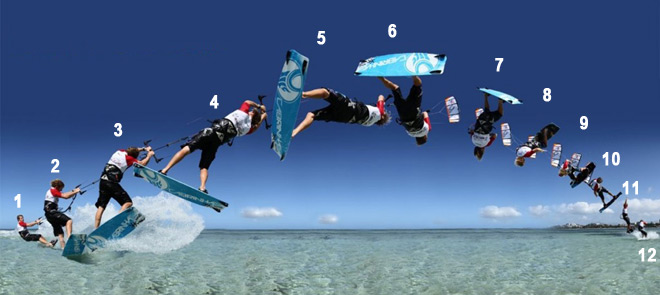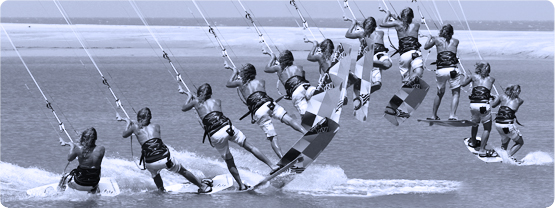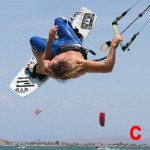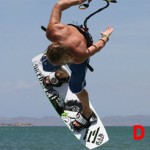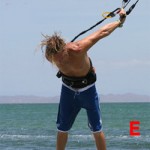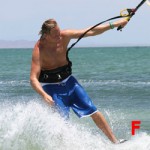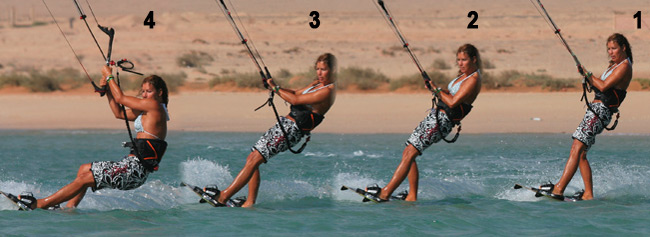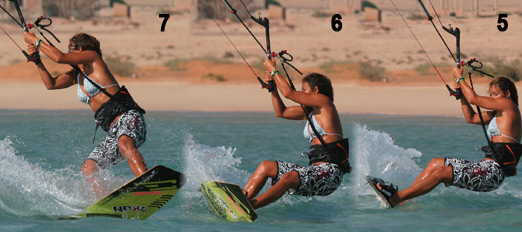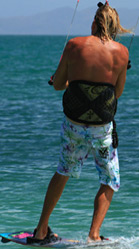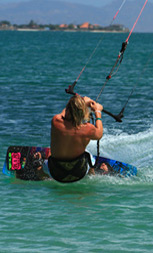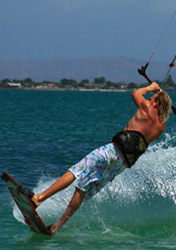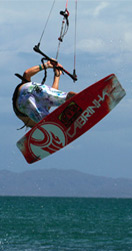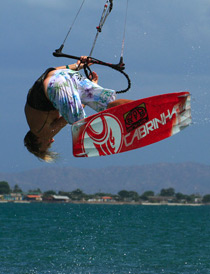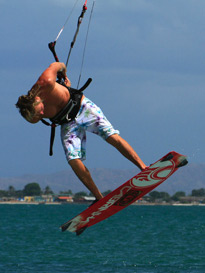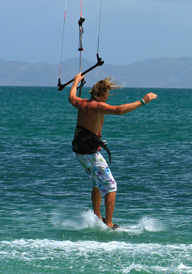Kite Loop

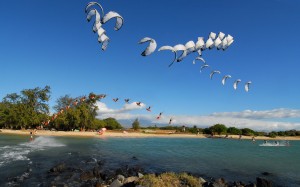 The kite loop is an extreme kite trick and you really need big balls to even dare try to perform this insane trick! As an “advanced” kite surfer this is however a trick you most likely will try to perform at least once! If you’re unlucky you might hurt yourself quite bad and will probably not be so keen on trying again! So a good theoretical knowledge about this crazy trick is an advantage before you try to do it practical. Follow this guide and you minmize the risk to crash, but first some ground rules.
The kite loop is an extreme kite trick and you really need big balls to even dare try to perform this insane trick! As an “advanced” kite surfer this is however a trick you most likely will try to perform at least once! If you’re unlucky you might hurt yourself quite bad and will probably not be so keen on trying again! So a good theoretical knowledge about this crazy trick is an advantage before you try to do it practical. Follow this guide and you minmize the risk to crash, but first some ground rules.
- Make sure that you are over powered to the limit using a relative small and fast(!) kite, 5-9 m2 is ok. I use a Royal Era though most new kites are fast enough.
- Be sure that the water is deep enough to not hit the bottom in case you crash.
- It’s best to start doing kite-loops with longer lines, don’t go below 20 meters during your first attempts to make kite loops.
- Have a stand by rescue buddy within reach!
Ok, so the preparations are done and it’s time to loop! Follow these steps:
- Jump as high as you can and when you’re just about to reach the peak, twitch the bar’s back side (if you going left, pull the right side)
- The kite will pass twelve and begin to loop.
- As the kite is about 270 degrees through the loop you will eventually start to fall and the lines might slacken a bit. Now don’t freak out. As you fall the lines will apperantly become stretched again and you´ll now be able to fulfil the last 90 degrees of the loop and the kite will catch you again.
- When it comes to landing, point the board fully downwind!! You´ll land with high speed and will not be able to land with your board pointing a upwind. Doing this can result in a twisted knee or two. Looking over your back shoulder as you loop will help you twist your hip and get you prepared for a landing with the board pointing downwind. Also avoid land on choppy water.
- That’s it! If you done everything correctly you should now be back in the water in one piece!
Good luck and don’t underestimate the use of safety equipment when you´re doing kite loops! Helmet and impact vest can save you months of boring rehab!
Front to Blind
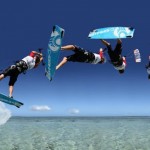
Our front loop love bubble wouldn’t be complete without adding the awe-inspiring blind landing a cheeky surface pass out. Tricks to blind looks phenomenal, feels sensational, and once you get the hang of landing blind; they will all start to be seen in your family of tricks.

THE KNOWLEDGE
You will need to get this move sorted in your head before you go and play. In theory, it is one and a half front rotation, but if you attack it like this, it will be much harder for you to land. To get the control and therefore consistency out of this move, you must consider it for what it is – a front loop, but then in preference to landing on a flat board off the wind as normal. Here are the two parts to perform this trick perfectly without you getting in a midst of nowhere.
CONTROL
No matter what move you’re attempting to blind, the key is having the move consistent so that you know how much rotation, how much speed and height you will have. If you practice your popped front enough, it will eventually feel natural to the point of the landing always being predictable. This way you’ll be able to think ahead, seemingly giving yourself time, and get yourself ready for a blind reception.
THROWING IT LATE
Landing blind in most situations is all about “throwing it late”. That’s to say you go for the twist to blind just before you land. If you try and go blind up in the air, there is a little chance of holding that position on the way down. The answer is to wait until you think it is almost too late, and then go for it. As you can see this will be difficult without having the rotation that you expect.
TWO HANDS ARE BETTER THAN ONE
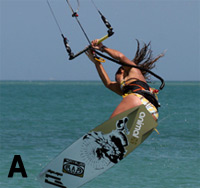 You may all want the style of some good surfers but you will have to build up to that. If you have been practicing your pop to raley to blind, you’ll notice that you are using your both hand t pull the bar in to rotate your blind. This gets the bar nearer to you, swings you towards the bar and in the front loop variant will stop you over-rotating. Admittedly doing it all one handed may look like “da bomb”, but it will be much harder, so get a grip. See pic A.
You may all want the style of some good surfers but you will have to build up to that. If you have been practicing your pop to raley to blind, you’ll notice that you are using your both hand t pull the bar in to rotate your blind. This gets the bar nearer to you, swings you towards the bar and in the front loop variant will stop you over-rotating. Admittedly doing it all one handed may look like “da bomb”, but it will be much harder, so get a grip. See pic A.
In this phase you are in the “throwing it” phase. You need to pull the bar towards you with both arms and it should be twisted already quite far around, you need to let go of your back hand followed by your body and twist all the way.
TWIST AND SHOUT
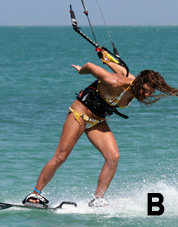 You are in the final phase now; this move is getting your body around to face the right way once you have landed. This will give you balance as it will stop you edging against the kite on your toes and it enables you to pass the bar. Like the surfer in pic B You should twist your left hand during the landing so that your thumb is pointing in the way you should go and this also will turn your shoulder more, then turn your head and look where you should go, which in turn puts your weight onto your heels and slackens the kite lines as you steer down towards the kite. It also puts the bar in place for you to reach up and grab it.
You are in the final phase now; this move is getting your body around to face the right way once you have landed. This will give you balance as it will stop you edging against the kite on your toes and it enables you to pass the bar. Like the surfer in pic B You should twist your left hand during the landing so that your thumb is pointing in the way you should go and this also will turn your shoulder more, then turn your head and look where you should go, which in turn puts your weight onto your heels and slackens the kite lines as you steer down towards the kite. It also puts the bar in place for you to reach up and grab it.
FRONT TO BLIND – ALL IN ONE!
1-3. Carv hard upwind against the kite to get enough lift and time to rotate. Position the kite at about 11 o´clock. If you put it closer to 12 you´ll lose your forward momentum and drop in the water without power. Position the kite lower around 10 o´clock and you´ll land with speed, eventually with too much speed!
4-5. Rotate and extend and turn your head to start spot your landing. Also don’t pull to much on your back hand since this will get much harder to perform the handle pass if the kite is to high.
6. Your are now in the same position as you would be in a simple front roll. Focus on where you will land and force your hands, the control bar and the rest of your body around as if you´re preparing for for a downwind land.
7. Now it´s time to throw the bar. Pull the bar towards you and twist your hip, legs and board further. Pull the back leg up towards your bottom and extend your front leg. This means that even if you land across the wind, the board will pivot under your right foot and end up further off the wind. If both legs are straight you will just hit the water and stop.
8. As you land make sure that your weight is on your right leg to allow the board to pivot further off the wind (of course your right leg will be the left leg if you rotate in the other direction as the surfer in the picture below).
9. Twist your hand and point your thumb in the direction you´re going.
10. Turn your head and shoulder even further
11. The turning will put the weight on your heels and take the tension of the lines, so you can bend over and get the bar nearer your back.
12. Pass the bar without and double-jointed contortionist skills =)
TOP TIPS
Whilst steering, try not to have too much speed, as landing a fast blind is a challenge for you.
KEYSTONES
1. Carve hard to go up.
2. Get enough height and time for the rotation.
3. Use both arms.
4. Let go of the body during the “throwing it” phase to rotate.
5. Throw it late.
6. Look where to land.
7. Control your twist after you land.
8. Twist and shout!
Some videos:
Front To Blind – Wakeboarding
Or why not add an extra front roll like Mike Blomvall and you´ll have a 720 Front To Blind
F-16
F-16
WHAT IS THIS, AN AIRFORCE JET PLANE?
No, the F-16 is a fundamental nature of an unhooked back loop kite loop, a kite loop being when the kite is hurled against the direction of travel.
Its core difference from the hooked in version, or in fact the purest unhooked version is the way that you hold the bar. As we shall see both hands will be grasping onto one side of the bar, which forces the kite to turn extremely fast. This in turn means that there is very little input from the surfer once it’s all begun, and that the kite will not produce g-suit necessitating forces. A real grin and bear it move, which is well within the reach of anyone who can back loop kite loop and unhook.
ANGLING
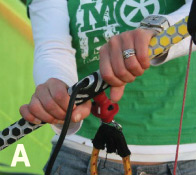 Pic A. Here we can see that the surfer is holding the bar with both hands centered in normal position riding to the right side.
Pic A. Here we can see that the surfer is holding the bar with both hands centered in normal position riding to the right side.
Now the surfer has two options, and it is up to you to see which you use. Knowing that you will need to get both hands on the back of the bar, you could either:
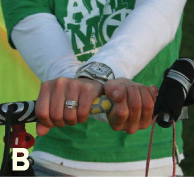 Pic B. Leave your back hand
Pic B. Leave your back hand 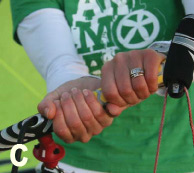 where it is, let go of your front hand and move it.
where it is, let go of your front hand and move it.
Or Pic C. move your back hand down to the end of the bar, release your front hand and grab the bar just the other side of the chicken loop in front of your back hand also with your palm facing up.
Both of these procedures work, although the first one necessitates less movement. Grab your bar and straighten your arms above your head to see which feels most comfortable.
THE KITE
The kite is very much dictating what is happening in the F-16. It will pull you up, it will rotate you and it will softly drop you back down once it finishes the loop.
It is very vital to trim your kite with the center line adjustment strap so that you are in control. Bowsexuals could leave a little more power in the kite as they do tend to turn quicker.
Doing an F-16, you will need to aim and position your kite very close to 12 o’clock above you. Like other powered techniques, starting while traveling slightly downwind will help. For the F-16, there are two grounds for this, other than the fact that it will be easier to unhook.
Firstly, once you have unhooked, if the lines are not completely tight, the kite will not move swiftly as you change your hands. This is very important especially on small kites.
Secondly, you need to do the whole rotation in the air. Most of us are used to doing the first half of a back loop by carving big time into the wind, which means that we’re already turned 180 degrees before taking off. If we do this for the F-16, we will overdo the spinning process. By cruising slightly off downwind, it allows us to carve for pop without turning too much into the spin.
THE YOU
The other main ingredient to a successful F-16 is an early take off. If you wait until the kite pulls you off the water, it will already have turned too far, and therefore pull you around too early, making landing a little wobbly or leading to a bad case of over rotation.
The best thing to do is to physically jump up into your back loop off your edge just before you think the kite will pull. By doing this, you’ll aim to finish half the spin. If you can look upwind while being at the peak of your jump, the kite will take over and bring you around for a nice soft landing. However, this may take a bit of practice to get the timing.
REAL TIME
The approach for the following sequence is identical to that of the down loop s-bend. Having had a very good look around to check that the coast is clear and that you have provided yourself miles of space downwind, slowly hurl the kite up towards 12 o’clock, flatten the board off to bear off the wind slightly and unhook. As soon as you have unhooked change your hands.
1. Once the hands have moved, it’s time to get back on your edge so that you’d still have some power to pop off. Do this by dropping your weight low and getting your shoulders out and upwind of the board. The bar is now vertical, this will happen automatically.
2. Just before the kite pulls, carve hard bending the rear leg ready to pop upwards. Your head should be looking forward in an effort not to create too much rotation.
3. Pop off; jump up across the air powerfully. Keep your head equally close to your shoulders. Your aim is to do half a back loop.
4. The kite has now travelled far enough behind that it pulls up.
5. As the kite starts looping, the power will extend you. The turning of the kite should pull you around.
6. When you feel the power collapse, look over your shoulder and locate a landing spot.
7-9. Remain focused on where you expect to land. The kite will have little power, and as a result, you will drop back towards the water surface. Grab and pull the bar in towards your hips to get your legs back underneath you.
10. With your legs dropping underneath, try and focus on pointing the board downwind.
11. On landing, try and maintain your weight over the back of the board.
12. Review where the kite is. If it is not travelling forward, let it continue to loop until it is, then release you upward facing palm (original front hand), place it back on the front of the bar and then hook in.
BEST TIPS
A speedy approach will make the pull from the kite seem far less violent while it gives you more control and a smoother landing.
If the bar is getting ripped out of your hands, try not to edge too hard for too long. Go downwind a bit more.
Try to imagine the F-16 as a game of follow the leader. As the kite loops you, just follow it around one step behind.
Dropping the back hand as you come down can help slow down the spin and also makes a speedy landing a whole lot easier.
If you keep on over rotating without getting any height, try not to throw a back loop, but ease into it by jumping up.
The more power you have in the kite, the higher and harder you will go. Just take it easy when learning.
This is how it should look after some practise 🙂
KGB
The KGB is the next step on from a back to blind with an air pass. Much like the excitement of a Blind Judge 3, the add on is the final 180 of rotation so that you land heel side, therefore completing the move. It’ll have you laughing on the inside for weeks once you claim it, as that final float around to your heels is one mighty achievement. We will of course advise that you should already be stomping back to blind with air passes, as then it is more a matter of tweaking and polishing rather than learning something from scratch. If you did nail the Blind Judge Three it will help a lot, as you’ll already have built up some muscle memory to get the passing and kicking movement for the heel side landing.
- Approach and Carve Pic A.
In order to get the height, pop and slow enough rotation your entry into the KGB must be bang on. First off make sure you come in well off the wind, so bear away a lot before unhooking. Why? This will let you carve hard enough to get your rotation into the back loop without turning too far into wind, and therefore you’ll actually “do” more of the back loop in the air, and thus it will feel slower, giving you more chance to pass and turn. Secondly make sure you lean back towards the tail of the board as you bear away. You can see in the pit that the rider’s hips are leaning back over his back foot, and his shoulders are leaning back towards the tail of the board. This will help him invert, which in turn will make the pass both easier and closer so that he can pass later and therefore get all the way around to his heels. Finally don’t be afraid to have your kite a tad higher for learning this, as it’ll be more pleasant and confidence boosting knowing that there’s enough room to complete the manoeuvre.
- The Take Off Pic B.
Once you’ve got off the water with a right royal stamp against the back foot your aim is to get the board swinging up whilst you turn slowly through your rotation until you just about complete a back loop – but with the board up high and the bar in close. Here the rider has kept his hands in close to his waist from the off by locking his elbows in, and thus hopefully the bar will stay nice and close too and he won’t need superhuman strength to pass the bar. The rider’s head, although just about leading the rotation, is not looking over his front shoulder, but rather forward, perpendicular to his shoulders. This prevents him from spinning too quickly, thus helping him to turn the other way when needed and pass. Finally as his shoulders are still leaning back from the take off and his board rises the rider and brings his knees up and close, so that the board moves with him and doesn’t pull him down later in the move.
- The Inversion Pic C.
Getting the board up is what gives you time to pass the bar late and get your front foot through.
The timing and amount you turn can vary, but the more you complete the back rotation the better your KGB will look, much the same as a back to blind. The rider is coming around his back loop, not quite a full 360, but almost in relation to the angle he went off the wind to start, which gives him the most chance of landing comfortably downwind and not on an edge. Your aim is to get to this point with your board high and the bar still tucked in close to your hips. The further you come around the more your hips will come up towards the bar and save you having to pull your weight up to the bar, and this way you can rotate the opposite way for the pass without getting pulled backwards. Like many passes you will think you’ve left it too late, but this is your cue to go.
- Turn The Other Cheek Pk D.
Time to pull the trigger! Once you’ve completed the back loop you need to go for the pass before your board and legs drop and therefore pull you down and away from the bar. With two hands still holding the bar, The rider keeps his knees in and up whilst he turns his head to initiate the pass. The head should lead the entire move from here; if it does you can turn and claim the KGB. As you turn your head look up, not down at the water. The fact that the board and his feet have completed the back loop mean that the board is in front of him and therefore he won’t get pulled backwards away from the board but rather drop forwards towards it. This is not a bad time to give the kite a quick tweak down if you find that it keeps rising.
 However if you keep your elbows in your kite will naturally dip once you release your back hand, as all your weight will transfer to the front. The MAIN DIFFERENCE here to a back to blind with air pass, is that your focus is not on passing the bar but rather on spinning your head, body and board so that you can see where you’ll land. If you just concentrate on the pass you’ll drop down without turning the full 360 to heel side.
However if you keep your elbows in your kite will naturally dip once you release your back hand, as all your weight will transfer to the front. The MAIN DIFFERENCE here to a back to blind with air pass, is that your focus is not on passing the bar but rather on spinning your head, body and board so that you can see where you’ll land. If you just concentrate on the pass you’ll drop down without turning the full 360 to heel side.
- Forward Pass Pic E.
Looking forward to where you want to go will make you lead the rotation, so stretch your chin out in front of you and keep your eyes up. Normally you would turn your head down, and therefore pass but then drop down. In a KGB you must keep the head looking above the water, searching for where you’ll land. Here you can see the result – The rider is still turning as his head and body are leading the way. As the rider turns he rotates onto the bar and can therefore pass, but the priority is the rotation and therefore the pass from one hand to the other is late. Finally if you look at Christian’s front leg you can see that it is still bent. Keeping your landing foot close will guarantee that it comes with you and doesn’t get left behind. Once you get this far, prepare to scream and celebrate, as the KGB will be yours.
Top Tips
- The foundation for this move is a decent slow and inverted back loop, so repeat as many of these as you can, getting the board high and finishing your rotation at the apex.
- This will get you prepared and visually ready for the final 360. If your feet are dropping as you come around your back loop, you need more inversion, so more leaning back, more locked elbows and more knees up.
- We won’t be adding any common problems for this move, as it is a matter of concentrating on the relevant skills and putting them together – an inverted slow back loop, and a pass rotation lead by you head held high.
Keystones
- Massively off the wind
- Lean back towards the tail
- Hands in, knees up
- Full rotation to inverted position.
- Lead the pass with your head held high and front knee in.
Unhooked Front To Blind Ole
There are a few takes on the front to blind, powered, unhooked, hooked, sent kite, you name it and it’s probably likely. We’re adding the unhooked Ole to the list as it serves a couple of purposes. Firstly it does allow you to go for and learn the blind with a slightly higher kite. Secondly on a big lefty kite in light winds, you will often need to have the kite a bit higher and with the resultant upward pull on the bar “Oleing” out is a health conscious option – oh yes and it does have a different look and feel to a standard bar pass ending. Before you attempt this we’d suggest you can pop front roll, and preferably relay to blind, but if you’ve got the hooked version down then this is a mere step away. Following are a few points worth more than a moment’s consideration.
- Take off, pause and rotate Pic A.
As with all things unhooked and popped we’ll assume that you’ll have the bar trimmed correctly, hands centered and approach with good speed before bearing off with your weight back to unhook, dropping low and edging hard into your pop, stamping hard to get the height without a cheeky kite send. If you use your kite you’ll lose forward momentum and the landing will be difficult to pull off.
For extra lift when learning you can have your kite positioned higher, just above 11 or 1 o’clock – but don’t move it up. Here the rider has her kite parked at 11 o’clock and has just popped hard to get up off the water. What’s clear to see is that the rider has not yet started her front rotation; she is still looking forward to where she’s going. You too must separate the movement, even if only by a fraction of a second, but you need to pop before throwing your head and shoulders down and around. As a result you’ll get the height, if not you’ll be diving yourself down into the water and onto your back.
- Front Hand Pic B.
Whilst rotating around, especially if you have the kite high, it will be very tempting to lean on the back hand, and also very natural to have pulled on it whilst edging to pop. Therefore as you spin around it is very good form to keep applying a bit of pressure onto your front hand as this will both stop the kite from floating up above you, and it will keep the kite moving forwards, which will make the landing easier as you’ll have momentum. The rider is only just into her rotation but she is already “leaning” on her front hand. This means that when she finishes her rotation she’ll be able to pull herself towards the bar to throw the blind – if you end up hanging under the bar you can only spin to blind, which won’t offer you any consistency.
- Look Pic C.
We’ve said this before but whether it be a hooked front to blind or an S-bend pass the principal is always the same, another very brief pause between finishing your rotation and throwing the blind. This prevents you from over rotating and you have much more chance of keeping the kite in the air, rather than releasing one arm and starting the mother of all down loops.
Here the rider has rotated the full 360° and is focused again on where she’ll land. This momentarily slows her down, almost pauses the rotation, enabling her to set up for the blind. If not she would be spinning under her kite. From here she can now pull on the bar hard with both hands and throw the blind. With her head, hands and bar leading the rider can throw the blind and swing her legs through to turn far enough for the landing.
- Landing Pic D.
Landing blind for an Ole or pass needs to be flat on the board, downwind, not on an edge across the wind. This way you’ll be moving toward the kite and therefore there won’t be any tension on the lines.
Sc bearing away into the move is important, as this leads to a more downwind landing, and pulling hard before committing to the blind will also help. In the photo the rider’s board is off downwind so her momentum will keep her moving towards the kite. Now what differentiates an Ole from a surface pass here are the position of the rider’s body and her bar. The rider is standing upright over the board with her head high, not bent over double, and she is holding her bar high above her on an outstretched arm. This position is the perfect set up to an Ole.
- The Ole Pic E.
Firstly let’s remember what an Ole is. You will be moving the hand that is holding the bar, across, upwind of your head and shoulders to the other side of your body, from where you’ll be able to continue riding, but now toe side rather than blind.
That’s all it is, you’re not trying to turn the board or slide it around to bedside. It’s an upper body movement to get the bar across to the direction of travel and no pass is required. You can see in the photo that because she is travelling towards the kite the rider can push the bar upwind of her and then simply move her hand across in front of her face – now the bar is the same side of her body as the kite and the natural order of things are restored.
- The Finale Pic F.
You have a few options to finish things off, and regardless of what you do it’s a good idea to get both hands back on the bar so that you get control of the kite. Continuing on toe side shows good control, and will certainly confuse a few onlookers. That said if you land with a lot of power and speed the chances are that you will carve onto your heels, so keep going and ride out in the other direction. Here the rider has pushed the bar across, finished her Ole and is reaching for her bar. She has a lot of weight on her heels and as a result will steer her kite across the window once she has her back hand on the bar and follow it by continuing to carve on her heels.
Top Tips
- Apart from making sure that your popped front rolls are working off pat, the secret is to land blind and yes you’ve guessed it, pause foss split second before attempting the Ole.
- If you rush the Ole you’ll fall backwards or if you really rush the Ole you’ll start to rotate into it before you’ve even landed. So first land, balance and then push the bar.
Common Problems
- Assuming that you can get to blind the main issue will be falling backwards. This is normally a result of leaning back to push the bar across your face, rather than keeping your weight balanced and physically pushing the bar up wind and past.
- If you land on your toes across the wind the lines will tighten and you won’t be able to push the bar without it pushing you back, or you leaning back.
Keystones
- Pop then rotate
- Look and pause
- Pull with both hands then throw
- Land downwind and flat – pause
- Then push the bar upwind and across
Kite Loop Handle Pass
The KL3 is a genuine pleasure to tame. Having a bit of pull from the kite and chucking a pass in to boot should get you cheering yourself on even without witnesses. Best bet before trying this would be to get your shifty 3 down, as that way you’ll be used to the rotation and muscle memory should prevail when you pull the trigger. For the more cautious amongst you, the progression step before this is the kite loop to wrapped, which we covered in Issue 21. It goes without saying, we hope, that at the very least you can comfortably and confidently stomp your unhooked fish polled kite loops!?
Approach and Pop
Perhaps a slight recap is necessary as your parting with water moment should be bang on to give you maximum hope of adding a pass and landing. Firstly you’ll need some height and therefore some up pull from the kite, not just some mad demonic downwind tug. Starting with your kite high, near as damn it to 12 o’clock will make all the difference. Trimming your bar down is also essential as not only will this make unhooking with your kite high possible, but it will also encourage your kite to loop, rather than spin on its axis. In Pic A. The rider has already set his kite at 12, flattened the board off to unhook with his hips up.
Lift Off
As you get launched into the air you must be ready for the put as the kite starts to turn. Having popped up hard you will be extended, but in order to take the power and still be able to rotate you must brace and balance yourself.
Pic B. As the rider explodes up off his back foot he puts all his effort into 2 things. Firstly he keeps his elbows in as tight as possible, so that his arms won’t extend too much as the kite pulls, which in turn will keep his body closer to the bar and ready for the pass. Secondly he pulls his knees up, making himself small, so that his legs and board don’t get left behind, and therefore have a chance of coming through and under the bar when he rotates into the pass. In short the rider is trying not to let his body extend into a Raley position. Flick and Kick those of you familiar with the shifty 3 will be aware of the spin that your back leg can create as it comes towards the bar for the pass. The KL3 is no different in that you’ll spin more quickly if you can “involve” the back leg. In fact here it is almost easier as rather than having to kick it out behind you, the whip from the kite will tend to flick your back leg out, so just concentrate on keeping the front leg in and your back leg will be poised and ready to strike.
Pic C. At this point the rider is watching the kite as it goes through the bottom of its loop and starts its journey back up. Keeping his elbows and front knee in the whip of the kite pulls him towards it, which conveniently flicks his back leg out, ready for the pass.
0 – 60!
As well as physical effort the timing of the pass will make or break this move. Although feeling is generally preferred, watching the kite during its loop is no bad thing as you need t “go” before the kite climbs back up in the window, as this will be the moment of least pull and the bar will be light and not pulling away from you. Pic D. As the turbo drops off, the rider pulls the bar down and back towards his trailing hip hard with both hands, so that his upper body comes up towards the bar.
Simultaneously he pulls and swings his back leg up towards the bar, which not only helps him lift the board but also generates the momentum for the pass. You can see how close his body is to the bar now.
The Pass
No rock& science here, as all the usual rules apply. Assuming that you went early enough the kite will not be pulling the bar away from you, so the key is committing. Therefore as your back knee comes through you must release your front hand and turn your head and shoulders so that you don’t block the rotation. Also you must hold onto the bar with you back hand until you can reach it with your free hand behind you. By holding onto the bar you can rotate around it, making the pass more achievable.
Pic E. You can see that the rider has twisted the bar behind him, which allows his shoulder and therefore body to rotate further around, almost rolling around the bar. This makes the pass simpler as by rolling onto the bar, it places the bar easily within reach of the searching free hand. Hence the progression from wrapped, as realistically you are first wrapped in the air, before passing.
Claim it
Once you’ve passed the bar preparation for landing is key. You need the board underneath you and your head looking forward and held high, whilst keeping your arm in as close as possible so that you complete the rotation sufficiently to land with the board heading down wind. Pic F. The rider has dropped his under carriage so that he’ll land on the board. Chances are that this will not be the softest of landings, so he’s lifted his head so that he can stand up and take it, whilst his elbow holding the bar is bent so that his body will follow the kite downwind and complete the rotation.
Top Tips
- As is so often the way the fundamentals are key, so hammering out a few unhooked kite loops first will acclimatize you to the wind and more importantly the kites arc.
- Watch the kite and feel for the flick as the kite whips.
- This way you’ll be able to anticipate the dead point, where you’ll have the slack to pass. If you it for it you’ll miss the moment.
- It will make good sense to learn this with less power and build up from there. If you can nail a pass on a low fly by just before landing it counts and the consequences of it not working are just a splash.
- We won’t be adding any common problems for this move, as it is a matter of concentrating on the relevant skills and putting them together – a comfortable kite loop with an explosive rotation.
Keystones
- Pop early
- Elbows in, Knees up
- Pull bar and swing back leg immediately after whip
- Hold on with back hand to roll around bar
- Get upright for landing and hold in front arm
Blind Judge 3
We’re expecting that you can already stomp the blind judge, and therefore we’ll tweak what you have to move you towards the full monty. In tech terms, considering that you should land a blind judge pretty much down wind, you’re only going to have to turn just over another 90° to claim this one, but that’s a bit like saying you only have to pass the bar in the air to convert the blind landing into a judge, only. It may not sound like much but it’s worth the effort, as it will quite literally feel stunning to land back on your heels – boom! We’ll walk you through the bits that we think make the difference and get you all the way around.
The Approach
Yes once again if you don’t start this right you’ll be emptying your bladder into the wind, whilst banging your head on the proverbial brick wall. First things first, where you start is where you’ll finish, so if you want to land heel side pointing downwind you better bear away so that you’re pointing very downwind before takeoff to help your chances. If not even if you rotate all the way you’ll land on an edge and butt check at best.
Finally and looking at Pic A. you’ll need to get your body and weight into the right position to control the speed and pop. This should be nothing new but you can see that the rider has his hips back over the back of the board, his front leg extended, his shoulders behind his hips and his elbows is This is only possible if you bear away in this position so don’t carve off the wind and bend your front knee!
The Carve
You need to be super aggressive here to get maximum pop, so fight for it if this was a close up you’d see the rider’s rather pained kite face, there’s some effort involved.
Pic B. From the good approach position the rider was able to quickly carve back onto his edge by turning the board back up wind. To resist sufficiently the rider does not allow his back leg to bend more than it was before he carved – you can only use the bend that you have to pop. At the same time the rider’s front leg remains fairly straight which keeps his hips back and low. The final battle is to keep his front elbow in to stop the kite rising as he carves against it
Pop and Flick
This is definitely one of the most influential moments in learning this move, the flick which follows your pop.
Pic C. By resisting hard, carving hard and popping hard but late, the rider’s board flicks around behind him, turning his waist and shoulders upwind, so that the board is more vertical than horizontal behind him.
To prevent him from rotating the rider keeps looking forward and keeps his arms in, but he doesn’t resist this movement as it is the coiling of the spring! In this position the rider’s legs are straight, he doesn’t let his knees bend and feet lift. If you’re used to letting your knees bend your feet up behind you, you need to work on this straight flick. From here you can use gravity to gain maximum speed to spin effectively. If the feet go up you only have your knees travelling a short distance, as opposed to the weight of the board coming from far behind and one side to the other.
Pull and Turn
The flick is only transient, because no sooner is your board behind you than you need to get a move on and throw the 3.
Pic D. As soon as the rider can, he pulls hard on the bar to get his head and shoulders above it and swings the board forward. With the board and his body coming from that turned upwind position, it starts to turn the rider as soon as he moves. Worth noting as well that as the rider pulls on the bar with both hands he is already twisting it around ready for the pass. In comparison to a blind judge the rider does throw himself into the rotation, committing to a full rotation from the off. Think of it as a full flat rotation as opposed to a blind judge with a heel side landing. The basic difference here is that if your board is horizontal it swings forward and down as you pull. From the flicked position, as soon as you pull you automatically start to turn and therefore build up momentum for a full 360°.
The Pass
Hopefully the extra pop and direction of spin created from your flick will allow you to keep two hands pulling on the bar for longer whilst still allowing you to turn. This should then allow you to pass the bar nearer to you, whilst you remain more upright with the board underneath you. If you’re comfortably landing blind judges, then concentrate on passing the bar later, allowing your body to turn further before reaching for the bar. Pic E. You can see in the picture that the rider’s hips are over the board, so he is rotating with the board. The rider achieves this by keeping his head more upright, so don’t tuck your chin into your chest. You can also see that at the moment of passing the rider’s head is turning to look forward, keeping the rotation alive. Finally the rider’s trailing leg is bent.
You must keep this leg, your front landing leg bent so that it doesn’t drop down away from you, preventing you from completing the full 3.
Getting it round Pic F.
The final hurdle. You can see that as the rider releases his front hand he keeps his back arm bent and the bar close. This will keep him moving towards the kite and prevents him from dropping down. The rider’s head is still turning to look for the landing, bringing his shoulders with if now whilst holding the bar in close the rider lifts his front knee through with the rotation and twists the bar around in front of him, so that the bar will lead him as he comes around, bingo.
Top Tips
- They’ve all been mentioned, but start well off the wind, go for the flick and pull early. Really spin into the rotation, committing for the full 360 and pass the bar late so that you turn further, leading with your head held high.
- Once you pass the bar keep your knees and board up, and the bar in close, so that you can roll your front shoulder towards the bar waiting in front of you…. To get yourself in the mood and your head around it, try to get the full 3 without passing the bar, so let go when you should pass but aim to get your body and board around.
- Don’t however practice this method too much as you don’t want muscle memory to remember the letting go.
- You will need time and height to land this, so as well as going early you can sneak the kite up a fraction as you pop, but don’t wait to see if it’s enough, as then you’ll be its late.

Keystones
- Flick from take off.
- Immediately pull and turn.
- Head and knees up.
- Pass later in your rotation.
- Keep bar in close and lift
Double Back Roll Kite Loop
Hey guys! This week lets rock with double back roll kite loop and find all the possible way to complete this trick.
This one harks back a bit, watching some of the early adopters pulling the trigger on one of these back in the day was a sight to behold, large kite, no depower, heavy mutant strapped to their feet, and serious landings! Fortunately things have moved on and tricks like this are open to anyone and everyone, so certainly worth a bash and a lot of fun – possibly feels better than it looks.
As a prerequisite we would advise that you have a decent back loop, so that you can control your rotation and you know where your kite is, and some experience with looping the kite as you’ll be happier if it turns. Other than that as long as you’re not maxed it’s game on as this move is more about commitment and timing than finesse and technique
The Approach
Pic A. This is a sent back loop, so you’ll need to come in with good speed on a solid edge and your kite no higher than 1 or 11 o’clock. With a good edge you can confidently send the kite hard enough to get sufficient height, happy in the knowledge that it won’t drift too far behind you because the lift will come early. For this same reason you must keep the bar in on the sweet spot when you send the kite. If you let it out the kite will drift further back before taking you up, and the result will be a low and slow kite loop – not ideal.
You can see in image that the rider has speed and is low on as much edge as possible, driving through his back foot to resist the extra pull from his send. This will give plenty of up and keep tension on the lines during the back rotations – important for the moment you pull the bar to loop the kite. As for a normal back loop you should aim to take off with a bit of upward stamp off the back leg as this will also keep the kite above you.
Pic B. Although this is a double back loop, you don’t want to be throwing a super fast spinning rotation. For those of you who can already pull of a single back loop kite loop, it’s a similar theory. In the single version you only perform half a back loop and the kite does the rest.
Here for the double if we can get one and a half the kite will do the rest. Otherwise you run the risk of over rotating when the kite pulls, which won’t be the most comfortable of landings. Your aim is to rotate at a speed that will get you around 360° by the time you get to the apex of your jump, the higher you go the slower you need to spin. So give the take off a bit more than you would for your normal back loop. Even though you don’t want to overdo it, you do need to get yourself into a position from which you can rotate and maintain balance. Here the rider is already half way around his first rotation. He’s tucked up small, knees up, board close, so that he doesn’t stall or slow down. However his head is still looking through his arms, he’s not thrown it into the rotation. And he has the bar leveled and pulled into the sweet spot, to keep the kite from drifting back and also keep tension on the lines, so that the kite is primed.
Do It
Pic C. Assuming that your kite hasn’t drifted too far back you should still feel it supporting/floating you as you come around your first rotation. This is the moment to pull the trigger and loop the kite. If however you feel that the kite is way behind you and that you are already starting to fall, it’s best not to pull. The rider’s momentum is taking him into another rotation. He still has the bar in and is tucked up, so all he has to do is pull in hard on the back of the bar and push away with his front hand. As fun as it is to get as much power out of the • loop, when learning you want it to get around fast so be positive with your bar movement. You can see that the rider has his back hand slightly down the bar, whilst his front hand is near the centerline. This means he can pull easily on the back, and keep the bar on the sweet spot with the front.
Turbo
Pic D. Once you pull be ready for the kite’s power to pull you around. Here the rider has now turned his head to look over his front shoulder. This will help him “go with” the kite as it loops, meaning that he’ll turn slowly as the kite pulls him around. Once you’ve got here you are fully committed, so keep pulling and don’t let the kite pull the bar out and away from you.
Around to Land
Pic E. As the kite goes through its loop and starts to climb, keep the bar in and the kite turning. As long as you keep looking, keep the bar in and keep the kite moving you’ll come around. Once you can see your landing as the rider can here you know you’ve made it. Only thing left is to land downwind and then get back on your edge quickly to get tension on the lines and get the kite back under control.
Depending on your height and the speed of the loop, you may need to dive the kite hard to prevent it from overflying behind you!
Top Tips
Before bashing on with this, definitely bang out a few back loops to work out how hard you should send the kite and how fast you should rotate, then you can amp up the rotation a little bit and add the loop.
This move is all about timing. As long as you don’t let the kite drift too far back on takeoff, and pull for the kite loop as you start your second rotation it will work. We’d recommend not trying this too powered up to start with, work your way up in steps, both height and power, as you don’t want to be coming in on your side or back!
Common Problems
- Kite drifting too far back during first rotation. Chances are that you let the bar out as the kite started to lift, and/or you didn’t send the kite hard enough.
- If you want to tone it down it is better to give a hard but short yank on the bar than to slowly drift the kite.
- If you’re over rotating and starting a third back roll you are either pulling for the loop to late, or spinning yourself into the first rotation with too much energy. The quick his is to make sure you pull on your back hand as soon as you start the second rotation as the kite will pull you out of it foss down wind landing.
Keystones
- Approach as for a jump
- Good send with bar held in
- Make yourself small
- Pull hard as soon as you start 2nd rotation
- Keep pulling and turn head as power comes on
Toe side front Roll To blind with Ole
We hope you are grooming well with the aid of our articles and learning every trick carefully. With ever learning day, you are going to be perfectionist in this sport. We always emphasize on doing every trick with right way and right balance, so that your every step of learning should be placed on right path. The trick which we are going to learn today has a better name, but for the moment we’ll stick to the descriptive version. Fundamentally this is a pop trick, but a subtle drifting up of the kite is more than tolerable to get you easiness to learn this trick. For those of you confident with your toe side edge this is a great trick and an inspiring step on from the toe side pop to blind which is a good prerequisite as you need both a decent pop from your toes and the blind that very same side. If this will be doing it first time, let us advise again that it will be easier to pop from your strong toe side to a new and unvisited blind rather than try and pop from your weaker toe side. Popping well from your pinkies is the key here.
The Approach
We need two things in order to pop from your toes, first speed and then a good solid edge. With the board fizzing over the water it’ll be a doddle to get it up and you’ll have momentum when you get it around. Looking at Pic A. you can see that the rider pre pop. First off the rider has his bar trimmed in close so that he can get an aggressive edge and hold the power with two hands without being pulled up onto the board. This way he can turn his head and shoulders away from the kite and stand up onto his toes, hips forward, driving the board between him and the kite. The rider has shifted his weight back on the board ready to pop, as this will help him add tension to the lines by edging harder. However if you need more speed you must keep the front knee bent and the board trimmed flat before shifting your weight back.
The assumption behind popping is much the same as from heel side – once you have enough speed, carve  up hard and stamp off the back foot. Though bearing away and then carving up from toe side is no simple task, so for the same sort of effect shifting your weight back will dig the tail in and turn the board upwind on its rocker. The trick is to be quick, shift your weight back and stamp – wait and you’ll lose your speed and nothing will happen. In Pic B. the rider has leant his weight back and simultaneously drifts the kite up slightly from 11 o’clock to give him a bit more lift whilst stamping down hard by explosively straightening his back leg. As he pops up he turns his head and shoulders down and around, initiating the front roll.
up hard and stamp off the back foot. Though bearing away and then carving up from toe side is no simple task, so for the same sort of effect shifting your weight back will dig the tail in and turn the board upwind on its rocker. The trick is to be quick, shift your weight back and stamp – wait and you’ll lose your speed and nothing will happen. In Pic B. the rider has leant his weight back and simultaneously drifts the kite up slightly from 11 o’clock to give him a bit more lift whilst stamping down hard by explosively straightening his back leg. As he pops up he turns his head and shoulders down and around, initiating the front roll.
The Rotation
The rotation will be very quick as with every front roll from toe side. This is handy, as you’ll need to spin quickly to allow for the extra twist to blind. Aim to keep two hands on the bar until you are coming around the first 360°, as this will keep you more upright and lead to a smoother landing. Looking at Pic C. as Christian reaches this point you can see that he is leading with the head. This is important; as he will know when to initiate the blind once he spots his landing. The rider here also has his knees bent and board up to help encourage a quick rotation and he keeps the bar in for that little bit of extra float. As he focuses on where he’ll land he releases his back hand, turning his head and shoulders down and around under the bar so that he can get his body around to blind whilst the board is leading. This way the board will be beneath him and ready for touchdown.
Throwing Blind
We can see in Pic D. that the rider has “thrown” the blind with the result of turning his head and shoulders down. As he drops his feet and board are leading the way. Whilst turning, he tweaks the kite down by pulling gently on his front hand. This will guarantee a bit more speed and forward momentum for the Ole, and is necessary if you sneak the kite up for takeoff.
As with all things Ole or pass you’ll need to land blind on a flat board heading at least a tiny bit downwind towards the kite. This way you’ll have no tension on the lines and so the Ole should be a walk in the park. Pic E. the rider lands upright over his flat board, having thrown the blind enough to land slightly off the wind. Try to keep your head up, as this will prevent you from breaking too much at the waist, which can in turn force weight onto your toes and put tension on the lines! If anything you want to be leaning on your heels. Landing this way the lines will be slack and therefore the bar will be close to you, not twisted around leading the way and pulling you over.
Landing upright on a flat board heading towards your kite sets you up perfectly for the grand finale, the Ole. Pic F. Standing over his board the rider can now push the bar upwind and around in front of him, so that the blind miraculously transforms back into toe side. Once the bar is across get both hands back on it, sheet in and ride off with a hefty grin on your face.
Common Problems
- If you’re not getting enough pop from toe side try sailing more across the wind before dropping your weight back and popping.
- If the kite is falling out of the sky as you land make sure that you are both popping hard into the front roll and that you give the bar a tweak forward to keep the kite from drifting too far up.
- If you slide under the kite on landing try throwing your blind more aggressively by turning your head and throwing your free hand around.
- If you’re getting pulled over & catching your heel side edge, you’re not landing enough downwind.
- If you can’t Ole and the kite pulls you over you’re edging on your toes whilst blind, so make sure your weight is on both your feet, biased towards your heels.
Keystones
One Foot Front Loop Transition
Our book of kite surfing is full of tricks and with every chapter we disclose something useful and new for you. This move is a bit of a classic from the archives. Please have a deep view on below sequence and picture steps, which will make it easier for you to do successfully.
- The Take Off.
Ideally your goal with a pop transition is to land it with a diving kite without the need to add a late kite loop, as the later is really just a way of saving a mistimed attempt. This means that you need to pop up off the water earlier than you think and pretty hard, as this is what’ll give you your height. You need to keep tension on the lines to support you and stop the kite drifting back too far, and you’ll need to keep the kite sat fairly still above you whilst you pendulum out and swing back to land.
Pic A.
For his take off the rider has checked his speed by edging hard upwind, as if he comes in too fast he will swing too much.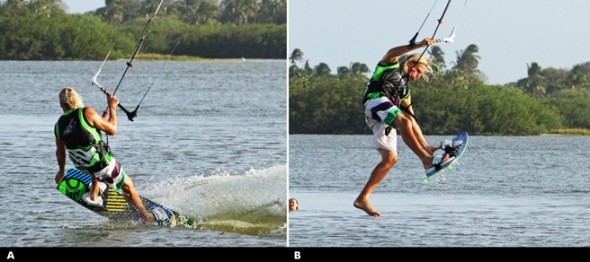 He has moved the kite up to twelve with his back hand centered on the bar and keeps the bar in to get the lift as early as possible before the kite gets to 12. As soon as the kite starts to pull the rider stamps down hard off his back foot and pops up and forward into his rotation, whilst already reaching forward for the grab (got to get the foot out early). Final point to note is that the rider does not yet turn his head for the rotation, as he doesn’t want to spin quickly as this will make the one-foot harder.
He has moved the kite up to twelve with his back hand centered on the bar and keeps the bar in to get the lift as early as possible before the kite gets to 12. As soon as the kite starts to pull the rider stamps down hard off his back foot and pops up and forward into his rotation, whilst already reaching forward for the grab (got to get the foot out early). Final point to note is that the rider does not yet turn his head for the rotation, as he doesn’t want to spin quickly as this will make the one-foot harder.
- Foot Oct
Taking your foot out quickly and effortlessly will help no end, so it may be worth loosening your strap slightly. It will also help if you’re accustomed to this action, so at least run through it numerous times on land, but better still have the one footed jump in the opposite direction nailed, as the movement is exactly the same as a tail grab one foot that way. Here it’s a nose grab, but realistically you should grab the heel side edge of the board somewhere between the strap and the fin. Hold the board up with your toes pointing skywards, and pull your foot out and down to avoid the foot sticking.
Pic B.
The rider is looking at his grab and the foot strap, which makes both taking the foot out and getting it back in quicker, and this is the main reason for not throwing your head around over your back shoulder on takeoff. If you feel confident try and push your foot down towards the water to straighten your leg for extra style points.
- The Rotation Pic C.
You can see in the photo that even though the rider is focused on the strap he is still rotating, although slowly, from throwing his shoulder down towards the nose of the board on takeoff. As soon as he feels his back turning towards the water it’s time to get the foot back is Even though the kite gives some hang, as a pop trick you won’t have much time in the air, so as soon as you turn past 90 degrees you’ll need to speed things up if you intend to land facing the right way with two feet in the straps. In this image the rider holds the board away at arms length, which gives hiss enough room to lift his leg and get his foot above the board, whilst looking at the strap and keeping the bar in for support.
focused on the strap he is still rotating, although slowly, from throwing his shoulder down towards the nose of the board on takeoff. As soon as he feels his back turning towards the water it’s time to get the foot back is Even though the kite gives some hang, as a pop trick you won’t have much time in the air, so as soon as you turn past 90 degrees you’ll need to speed things up if you intend to land facing the right way with two feet in the straps. In this image the rider holds the board away at arms length, which gives hiss enough room to lift his leg and get his foot above the board, whilst looking at the strap and keeping the bar in for support.
- Foot In Pic D.
There is no point in attempting to land until your foot is in, and as you can see here even though the rider is swinging out under the kite as a result of keeping the bar in his concentration is focused on getting the foot is It will be tempting to look around as you feel the kite pulling gently from behind you, but don’t be put off, get the foot jammed in and then you’ll be ready.
land until your foot is in, and as you can see here even though the rider is swinging out under the kite as a result of keeping the bar in his concentration is focused on getting the foot is It will be tempting to look around as you feel the kite pulling gently from behind you, but don’t be put off, get the foot jammed in and then you’ll be ready.
- Landing Gear Down Pic E.
As soon as his foot is in the rider releases his grab and turns his head and shoulders to look around towards downwind. At the same time he pulls on his hand to dive the kite, and as the power comes on it will pull his the rest of the way around his rotation and hopefully he’ll drop down into a perfect tail first landing.
his grab and turns his head and shoulders to look around towards downwind. At the same time he pulls on his hand to dive the kite, and as the power comes on it will pull his the rest of the way around his rotation and hopefully he’ll drop down into a perfect tail first landing.
As long as you he gets your head around and dive the kite the rest will be surprisingly automated. If the kite has drifted too far back in the window you will need to loop it as you land to stop you sinking!
Top Tips
- For your first attempts a bigger kite will make life considerably easier as it won’t move so quickly and it’ll give you a lot more float and therefore time to rotate slowly whilst you slide your foot quickly out and in.
- It will make a lot of sense to master the nose grab front loop transition first as then it is ‘just’ a matter of adding and timing the foot as opposed to learning a whole bunch of new skills at the same time
- We covered the grab variation in issue 31. Do make sure you give yourself plenty of space and some deep water, as at first it’s likely that you’ll let the kite drift too far, in which case you’ll get ceremoniously dropped into the water, which won’t hurt unless it’s only a few centimeters deep.
Common Problems
- The real issue on these pop transitions is kite positioning, and coming out with the kite high enough that you can dive it for power The opposite from perfect is the kite swinging back as you pendulum forward, resulting in you dropping in and the kite fluttering down at the edge of the window behind you.
- To counter this you must keep the bar in whilst you drift the kite up. Start with the kite no higher than 1 or 11, give it to jab up and pop immediately. You can let the bar out slightly at the apex but there is already enough to think about
– Kite not too high
– Pop Early
– 1 Foot immediately
– Foot In then turn head
– Dive and look down wind
Raley To Toe Side
This sport of kite boarding moves with different styles and ticks. The benefits of this sport can be measured by its refreshment and popularity worldwide. Today we all like a Raley, and funnily enough most of us learn on our preferred side, favorite foot forward, leading to a solid heel side touchdown. It looks like an embarrassment to overlook the other side and deny yourself the kudos of flicking your board both ways. Therefore the Raley to toe side, and just to prove it is a genuine move it even has its own name, the Krypt. With no trouble you can gladly learn these both hooked or unhooked. In this article, we will be going through the unhooked variant, but be assured that apart from the actual physical act of unhooking the rest remains pretty much the same for both, from approach to landing.
The Approach A.
As in every trick your approach will always determine how well things will turn out. Please have a look in the picture that the rider has her kite just below 1 o’clock, she has turned the board off the wind onto a very broad reach, whilst keeping her weight both upwind of the board and back towards the tail of the board. You can also see that her front leg is extended and both her elbows are tucked into her sides. Not only is this the perfect position from which to unhook, it is also the perfect set up for a Raley.
Now over here Kite height is very significant, too high and you’ll fly, but too low and you may not have the confidence to pop, so a happy medium is required, at a height just about where your kite is happily flying forward without creating lift, as a reference point this will be just below 1 or 11. Suddenly bearing off the wind allows you to lose tension from the lines and unhook,  and it lets the kite drop back a touch so that it will pull you downwind, easier landing, once you pop. Weight upwind positions the board between you and the kite so you can pop without the kite pulling your shoulders prematurely over the board. Then weight back over the tail so that you can rapidly and professionally carve the board upwind to pop, the extended front leg helps this. Elbows are tucked in to stop the kite from pulling your arms out straight and you over the board. Now you are all set for the Raley part.
and it lets the kite drop back a touch so that it will pull you downwind, easier landing, once you pop. Weight upwind positions the board between you and the kite so you can pop without the kite pulling your shoulders prematurely over the board. Then weight back over the tail so that you can rapidly and professionally carve the board upwind to pop, the extended front leg helps this. Elbows are tucked in to stop the kite from pulling your arms out straight and you over the board. Now you are all set for the Raley part.
The Carve Pic B.
Your action carving up against the kite needs to be accurate and quick; or else the kite will win the tug of war. With your weight back over the tail of the board you only need to turn your shoulders and the board will carve spec the shape that some lovely board designer put there for such a purpose.
Please see picture B wherein the rider has turned her shoulders and the board carves upwind, putting tension on the lines and thus generating some resistance. This resistance is your platform to pop off. Though to make sure that you are in control you need to keep your position. The easier way to do this is not to let the kite drift up, which it will want to do as you pull against it.
The rider keeps both hands in, arms bent, but her focal point is on keeping the front hand close, as it’s natural to pull on the back one as she turns away from the kite. Also as the rider carves she resists the pull from the kite with her back leg, which combined with her arms allows her to keep her weight upwind, on that edge, turning the board towards the wind.
The Pop Pic C.
Raley is simply an extreme pop. If you’ve somehow managed to oppose on the aforementioned platform you will be in a position to, and have something from which to pop.  As the board turns underneath you it’s the right time to stamp. The rider feels the board turning under her, and more significantly feels herself being pulled forwards by the kite. This is her cue to pop. She pops hard against the board with her back foot by stamping down and extending her back leg as explosively as possible. Her front leg has remained extended throughout. The amount of pop you get will depend on a few variables -speed, power, timing, aggression, but your aim is to extend, really focus on straightening your legs, uncoiling the spring which is you.
As the board turns underneath you it’s the right time to stamp. The rider feels the board turning under her, and more significantly feels herself being pulled forwards by the kite. This is her cue to pop. She pops hard against the board with her back foot by stamping down and extending her back leg as explosively as possible. Her front leg has remained extended throughout. The amount of pop you get will depend on a few variables -speed, power, timing, aggression, but your aim is to extend, really focus on straightening your legs, uncoiling the spring which is you.
The Flick Pic D.
There are two possibilities in a Raley, to end up with the board horizontal and behind you,  or flicked around vertically behind you. The second talked option will make all number of tricks more attainable and the Krypt is no exception. This flicking action is simply a continuation of the carve upwind and by extending and letting the board go you should end up here.
or flicked around vertically behind you. The second talked option will make all number of tricks more attainable and the Krypt is no exception. This flicking action is simply a continuation of the carve upwind and by extending and letting the board go you should end up here.
In this position you are airborne you also require to take stock of what is going on lest adjustments need be made. The rider has let her board flick around by carving hard to get the board into the wind and extending fully as she took off. She now wants to make ensure that she is in control, and here that means that the kite is doing what it should. If you’re well versed in Raleys, you know that once you have it nailed the kite doesn’t move, but if this side is new chances are the kite will have gone up. If it has, steer it down, the rider’s bar here is angled forward to keep the kite from rising. You’ll need to utilize both hands. The rider will also be spotting her landing, that is to say she’ll be working out where she’ll most likely land so that she can prepare for it.
Landing Gear Down Pic E.
Gravity always wins and your legs will naturally fall underneath you,  which is the beauty with a Raley. That said if you start with your kite at 45° or below Newton may not be able to save you. You can see in the picture the advantage of the flick, the rider left foot is forward as her front foot was flicked around behind her. If you have a strong toe side preference, chances are that you’ll automatically keep this position, but just to make sure, try to bring your knees up towards you as the board falls. As your knees come up you can pull your toe side leading knee under the bar, much as you would for a gentle pop to toe side. Here in picture the rider pulls her left knee through underneath her.
which is the beauty with a Raley. That said if you start with your kite at 45° or below Newton may not be able to save you. You can see in the picture the advantage of the flick, the rider left foot is forward as her front foot was flicked around behind her. If you have a strong toe side preference, chances are that you’ll automatically keep this position, but just to make sure, try to bring your knees up towards you as the board falls. As your knees come up you can pull your toe side leading knee under the bar, much as you would for a gentle pop to toe side. Here in picture the rider pulls her left knee through underneath her.
The Result Pic F.
By pulling her left knee through and under the bar, the rider will now happily and happily  land tail first for a toe side landing and a Krypt claimer. By keeping the bar in close she lands over the board and is not pulled forwards by the kite. Once you have landed, either bear away towards the kite and hook back in, or casually pop back to heel side and ponder what you’ll do next.
land tail first for a toe side landing and a Krypt claimer. By keeping the bar in close she lands over the board and is not pulled forwards by the kite. Once you have landed, either bear away towards the kite and hook back in, or casually pop back to heel side and ponder what you’ll do next.
Top Tips
- The very first tip is to start off gently, you don’t need to be hounding along at Mach 10 with the intention of a full blown Raley.
- A decent extended pop will give you the feel, so concentrate on carving and extending your legs and body before landing.
- Also have a good look on images.
Common Problems
- If you find that you are landing very downwind and having to carve around onto your heels, the chances are that either your kite has drifted up, or your error have extended which means that the kite will pull you too far downwind. Keep your arms tucked in and don’t be afraid to dive the kite down to keep you going where you should be.
- If you are catching your toe side edge on landing you don’t have enough height, so either pop harder or try with your kite slightly higher in the window. These are the things to keep In mind.
Keystones
- Approach with weight upwind, back and front leg extended
- Carve hard upwind with arms in
- Explode against the edge with your back foot
- Extend and feel the flick
- Pull arms in and bring back knee through
Toe Side Double Front Loop Downloop Transition
Your box of tricks should be always full with surplus of moves; however you have to ensure that you keep up with the transitions too. Having more ways to change direction is never a bad thing so here is another one which will have you flying out gracefully with plenty of beans. When you start doing this we will definitely recommend a controlled front loop from toe side and solid down loop. Let’s have a quick idea at a few pointers that will hopefully make the learning a tad simpler.
The Approach Pic 1.
A huge height is not required for this, however some forward momentum and plenty of float is obligatory, so you’ll need to approach this more as a double front roll with speed and the kite parked at either 1 or 11 o’clock. You’ll be taking off from your toes and therefore trim is important, hence get your sweet spot down towards you. This way you will provide a decent committed edge and still have room to send the kite without stalling it. Your toe side stance needs to be solid in this position. In the image the rider has all of his body upwind of the board; both knees are bent and driving forward with all his weight firmly on both sets of toes, creating a decent rooster tail behind him. Once he gets sweet spot close in, he can get his shoulders and head committed upwind and the kite is not pulling him up onto the board.
so you’ll need to approach this more as a double front roll with speed and the kite parked at either 1 or 11 o’clock. You’ll be taking off from your toes and therefore trim is important, hence get your sweet spot down towards you. This way you will provide a decent committed edge and still have room to send the kite without stalling it. Your toe side stance needs to be solid in this position. In the image the rider has all of his body upwind of the board; both knees are bent and driving forward with all his weight firmly on both sets of toes, creating a decent rooster tail behind him. Once he gets sweet spot close in, he can get his shoulders and head committed upwind and the kite is not pulling him up onto the board.
Getting Airborne Pic 2.
Take-off is very important in order to get enough height and time from your toes.  Get it wrong and you’ll fly down wind and pendulum under your kite! In order to initiate your front rotation you need to get your weight back so that you can kick off your back leg and in order to go up you need to send the kite with a good push and pull from both hands. The rider has sent the kite with a decent bar action, and also keeping it on the sweet spot. If he pulled it in any further the kite will pull him up onto the board and he’ll lose his edge. The order of play here is to send the kite with both knees bent and then drop your weight back ready to kick off. You will lose speed and the ability to edge hard if you drop back too early.
Get it wrong and you’ll fly down wind and pendulum under your kite! In order to initiate your front rotation you need to get your weight back so that you can kick off your back leg and in order to go up you need to send the kite with a good push and pull from both hands. The rider has sent the kite with a decent bar action, and also keeping it on the sweet spot. If he pulled it in any further the kite will pull him up onto the board and he’ll lose his edge. The order of play here is to send the kite with both knees bent and then drop your weight back ready to kick off. You will lose speed and the ability to edge hard if you drop back too early.
Roll With It Pic 3.
Starting the front roll and keeping the edge for as long as possible will help an awful lot. When the kite lifts you’ll be stamping hard off your back foot, and extending up into your rotation with as much energy as you can muster. In image you can see why it is so vital to obtain the right weight onto the back foot. The rider in image is stamping hard against the edge to initiate the double roll whilst extending up. This keeps the tail of the board in contact with the water for as long as possible giving him added whip and height. The rider throws his head and shoulders down to add inertia and already centers the bar with both hands to stop the kite flying too far back
off your back foot, and extending up into your rotation with as much energy as you can muster. In image you can see why it is so vital to obtain the right weight onto the back foot. The rider in image is stamping hard against the edge to initiate the double roll whilst extending up. This keeps the tail of the board in contact with the water for as long as possible giving him added whip and height. The rider throws his head and shoulders down to add inertia and already centers the bar with both hands to stop the kite flying too far back
Moving Forward Pic 4.
Over here in this picture you can check that the rider only past the 360 degree mark. He has finished his first rotation whilst still on the way up and now starts his second. Having kept the kite close to 12 o’clock he has both float from the kite and he can feel where the kite is. You must commit to the second rotation so as soon as you come around the first continue to turn your head and go with the energy you created on take-off.
If the kite is above you or even a little in front of you, you are in right place to well place to start the down loop. We propose two reasons to initiate it now. Initially the pull from the kite will help pull you around the rest of the way. 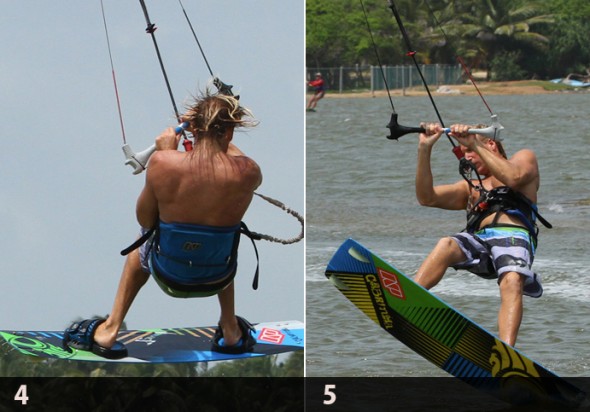 And then secondly the earlier we pull, the less aggressive, relatively speaking, we need to be on the bar. Your sits is for the kite to pull you out of the transition with speed and if the kite down loops too rapidly or from too far behind it will drop you down with no momentum.
And then secondly the earlier we pull, the less aggressive, relatively speaking, we need to be on the bar. Your sits is for the kite to pull you out of the transition with speed and if the kite down loops too rapidly or from too far behind it will drop you down with no momentum.
You can see in the images that the rider has his knees up tight, bar in close and his head is turned to rotate, all this will rooks hits turn faster. Looking at the bar you can see that he is already initiating the down loop.
Clean Landing Pic 5.
The moment of truth and another insight into the reason you must down loop early, gradually and continually. Looking at the rider in image you can see that he is landing right foot forward downwind on the tail of his board, all set to carve out of the “turn” and back onto his edge.
Realistically he isn’t finishing 2 full rotations; it is more like one and three quarters. So not only does the down loop give you speed but it pulls you out of the rotation. If you initiate the down loop later you will effectively over rotate and land on your heel side edge, stopping all momentum and you in the process. In final stage the rider keeps pulling the kite through the down loop until it is back up at 1 o’clock in the right position to ride away.
Top Tips
- To start with aim to get the rotations and a finish down loop, as this will be better than under cooking it with the kite, so when you do pull on the front hand, pull hard. This will however often result in you stopping when you land.
- Once you’ve practiced that a bit and having read the previous pointers you can see that the aim of this move is not to perform a double rotation and a down loop in the air, but rather get your rotation and use the down loop to pull you out with speed.
- Essentially you will be finishing the down loop as you land, not before. To get your head around this try some air gybe down loops If you go early and hard the kite turns, goes back up to 12 o’clock and you sink.
- Your sits is to progressively turn the kite more gently so that it will go through the bottom of the down loop before you land but as it rises it will pull you through the landing and give you a good speedy landing.
Common Problems
- If you find that you cannot edge enough when sending the kite, and therefore get pulled too much downwind whilst in the air – trim. Even if you have gorilla-length arms you need that sweet spot and the bar in close.
- If you find that you land with no power, as discussed above, you need to get the kite just in front of 12 just after take-off and then down loop the kite more slowly.
- If you’re landing on your hip and can’t get the board underneath you, this is a sign that the kite is down looping too low, so make sure you haven’t redirected the kite too much after take-off, and be a bit more aggressive when you pull on the front hand to down loop it.
Keystones
- Fast toe side with both knees driving forward.
- Rock weight back and send hard
- Kick up off back leg, head and shoulders down
- Redirect kite above you and stay small
- Start down loop progressively once you go into your 2nd rotation
Kite control is important in this trick and you have to initiate the down loop in the right moment. If you´re start down looping to early you might end up crashing hard like this guy
The correct way to do it is like this
Shifty 5
Everyday small progression in kiting is an important thing and also the most rewarding challenges. In freestyle the possibilities seem endless, moving from a blind landing with surface pass, to an air pass blind judge and then adding that extra bit tars blind judge three and then a five and then a seven – one can but dream or admire those that actually can.
Anyway the point is to those non-freestylers it all can look a tad uncontrolled with a lot of splashing, but if it’s your thing then every extra 90° or so means s00000 much. Taking your Shifty 3 and moving it on to a 5 is a highly rewarding yet achievable challenge – so here’s how.
To make that extra turn to toe side you’ll need more time. There are a few options available to you here. You could put your kite higher, which will help but the higher it is the more strength and effort you’ll need to pass, which may slow down your rotation.
You could go for the pass much earlier and therefore have more apparent time at the end to get around that extra bit although if you don’t kick the back leg it could make the pass trickier. And you could pop as hard as you’ve ever popped, although if you pop too hard you might get extended and pulled out which could also make the pass a tad more difficult. Realistically a subtle combination of all three is needed, with an awareness of how each will affect you. The one exception to all of the above is if you happen to be one of those people who can spin so quickly that you’re not sure what all the fuss is about
Getting Up There Pic 1
From the above you can check that rider is not coming into this with his kite at 45°, but as so often it won’t be above 11 o’clock as you must be able to edge against it, and any higher it’ll be lifting you – 10.30 is perfect.He’s come in with good speed and the kite parked still, with all his weight back over the tail of the board. He’s carved up hard and low and at this point has popped aggressively by stamping against the board, allowing his legs and body to fully extend upwards in an effort to get as much height as he can with this kite angle. His effort is focused ontwo things simultaneously, pop for height AND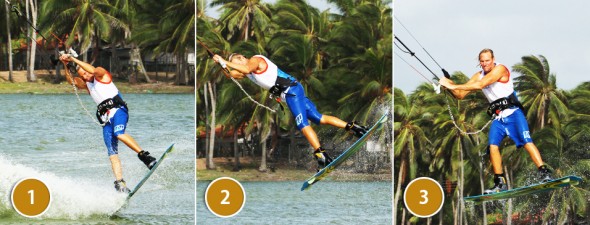 keep the bar as close aspossible. You don’t want your arms getting pulled out straight.
keep the bar as close aspossible. You don’t want your arms getting pulled out straight.
The Leg Kick – Shifty Pic 2
As you’ll no doubt know from your Shifty 3s, kicking the back leg out is to help with your rotation and if you happen to have a stylish shifty it’ll look better too. As soon as he is free of the water the rider kicks his back leg out, winding up some energy for his rotation and pass whilst keeping his elbows and hands in. This way he’ll be able to pull harder and swing his leg further.
Swing and Pull Pic 3
This is a crucial step as the closer you get yourself to the bar, the earlier you’ll be able to pass it and more importantly the less it will pull away from you once you have passed it. Remember that your airs is to go a little earlier so as soon as you have kicked your leg back, pull and go. You need to pull yourself up and over the bar whilst swinging your front leg under your elbows to get you rotating. This is a kite face moment as the effort should be extreme maybe even allow yourself a little grunt!
You can see that in comparison with the last picture where the rider head was level with the bar, he now has the bar coming in and down below his chest. And even though he has swung his back leg through and has started to rotate he still has both hands on the bar as he is still pulling himself up to it.
The Pass Pic 4
The passing action will be similar to your 3, that is to say you’ll be leading with your head and shoulders, turning yourself down and around, away from the bar, releasing your front hand, twisting the bar and then immediately hunting for the bar on the other side. If you popped hard enough and pulled hard enough you should get some slack here from the kite, which will help as the bar won’t get pulled out from you.
That said the main difference here to the 3 is if you look at the rider, you’ll see that his back leg is lifted with his knee coming up towards his chest. This is the precursor to getting the toe side landing, you really have to commit to this during the handle  pass, otherwise your feet and the board will drop away from you and you’ll have no chance to go that little bit further.
pass, otherwise your feet and the board will drop away from you and you’ll have no chance to go that little bit further.
Head, Hand and Knee Pic 5
And here is the result of bringing that knee up. With the knee up the rider can then bring it through towards his hand. The action is similar to that of a back roll to toe side, even though your adding the toe side on at the end you have to finish the roll with your back knee high so that you can push it through. It’s also important to keep the bar close, by that we mean don’t let your front arm fully extend as then you’ll used to Shifty 3s the chances are your muscle memory will encourage you to just drop out of the pass. Here you must keep your head turning so that it’s looking forward as this will allow you to turn your shoulders further so that your legs and upper body are moving together.
Just think how you learnt the side by taking the front hand off so that your shoulders could twist around. Here you can’t let that hand go so you’ll need to turn your head.
Get the Back Hand on Pic 6
This is almost THE top tip as well as being the final thought to ponder,  as once you get your head around what is going on, aiming for this from the moment you think about passing will help you get the 5.
as once you get your head around what is going on, aiming for this from the moment you think about passing will help you get the 5.
If you fry your damnedest to land with both hands on the bar it will make you turn your shoulders even if it doesn’t get on until you splash down, as is the case with our rider here in image.
Top Tips
- You’re going to need power, pop and height, but don’t confuse this with having your kite trimmed too far out, or should we say powered up in old
- If you do the kite will pull all through the move and it’ll be twice as hard.
- If you can think of only two elements of this move, they are to lift that back knee as you pass and fry to land with two hands on the bar.
- Have a gander at the full Sequence and Videos and try to see the early pre-empting of the toe side turn during the pass
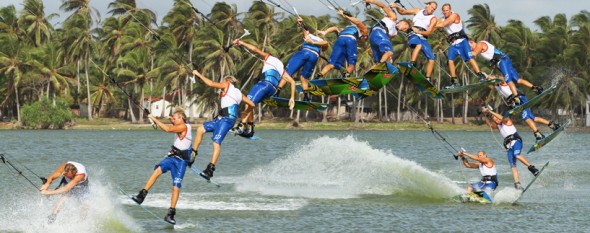
Common Problems
- If you’re dropping down out of the pass as per normal for a 3, take time to visualize what you’re aiming for.
- Then give it another 30% on your next try and think about bringing that knee up and landing with two hands.
- If you’re getting around but then fall on your back once you land. This means the kite is pulling you too much once you’ve passed, so either trim a little more or pull harder into the pass.
- If you don’t have time, go earlier and try to get some more height with help from the kite.
Keystones
- Come in with power and speed and pop super hard
- Shifty as soon as you’re off the water
- Then immediately pull up to bar and swing back leg through
- Lift back knee up and through as you pass
- Land with 2 hands on the bar
Double Front Loop Down Loop Transition
One of the advanced level tricks in Kite surfing is the double front loop transition. This is tried by mostly experts or advanced intermediate surfers. The technique here is mostly based on how you balance your forward momentum on the board and then move to height and bring yourself down on the downward wind and this is where you try out the perfect rotation of yourself. So to approach this trick there are couple of steps you need to follow.
First thing you need to do is basically place yourself on the board. This is done with the right leg placed straight on the board with the left leg behind in such a way so that it is used for pushing the board. As the wind speed increases the kite will start to lift you up and this is the point you need to start rotating yourself. Make sure you do not bend the back legs from the board as this basically slows down the entire rotation obstructing the perfect transition. The main idea here is to take you up on the first rotation and slide down in front for a smooth landing but you will notice that by the time you finish the first rotation and shift your head on the other side you are again ready to go for the second time. The next step is here when you and the kite are lifted up and you need to stay at 12 o’clock to the kite all this time by controlling the kite bar with front hand pulling it in forward direction. Every time you jump up the kite should be at 12 o’clock position and this is done when you rotate the body but your feet should be on the board. The impressive part of this is when you are lifted in the air and try to come down it descends slowly and gives you a feel of the kite and its forward movement.
A point to remember here is the kite should be always above you during this time otherwise the downward loop will pull the kite in front and you will be away from it. Always remember that the downloop will be slow and steady so that during this movement it will land you and also has the force to pull you forward. In fact you do not need to make the whole 720° as the downloop which helps in the smooth transitioning to landing also takes care of the turnings. But this is different from kite to kite and it matters on the sizes. For instance if you are using a kite which is slightly larger than the common ones available then make sure the front hand which is over the bar to move in the forward direction to control the high speeds which is controllable with two hands in case the kite is smaller. As you move forward with the wind, you will soon realize that how the kite quickly understands where to downloop and the downwind along with it also assists you in landing your kite.
Front Loop Kiteloop
This is a stunning move for those that really like ballsy tricks where it is all about setting up everything perfectly. Before going through the move, it is encouraged to simply “go earlier” and “pull of your life”, stepping it up a gear so you get focused on the move. This trick is all about commitment, once you have set the wheel in motion, you are a whole lot better off going the nine yards than trying to make your way out. The good news, however, is that you can build up into this trick and therefore save yourself onto any unnecessary spankings.
To give yourself a good chance of nailing the front loop kiteloop, there are definitely a few things that you should be able to do. Due to the fact that you’ll be looping forwards whilst the kite loops backwards, you will perform this move blind, as all the action will be happening behind you. The base for learning this move is a front loop transition, so this needs to be solid. On top of that, this shouldn’t be the first kiteloop you are attempting, as you really need to have your fast and sometimes hard and difficult landings down.
FIRST STEPS
To get your head around the idea of what is going on we will start at the front loop transition. Normally as you exit the transition, you should dive the kite hard. This pulls you out of your rotation and encourages you to land downwind. Essentially this results in the kite diving straight down through the window, and it usually takes a fair old tug to stop the kite from hitting the water. It is then when you carve back onto your edge and the kite rising which takes you back in the other direction.
Once you done a few front loop transition and feel comfortable with the approach. As you exit the move, just as your board touches down pointing off wind, rather than pulling the kite back up, pull harder with your back hand so that the kite loops under itself. This way you will follow the pull of the kite and carve out in the same direction that you went into the move, so no change in direction.
THE APPROACH
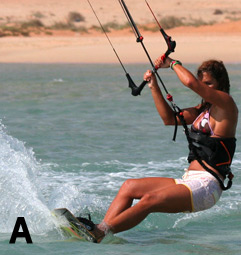 Pic A – Shows the surfer just before the take-off. If you look at her hand and the bar, you can see that the surfer has sent the kite back, but jump is not that aggressive. There are two reasons for this. First, you do not want to be jumping high because this move is all about commitment, make it easier to commit. Once you are three meters up, you may find the thought of looping your kite-less appeal. Second, you do not want your kite to go too far behind you. The further back it goes, the lower it will loop, which in turn means a heavier landing. Apart from the gentler sending, much as transition, the surfer is still carving hard against the kite off his back foot and dropping his weight against the upward pull of the kite.
Pic A – Shows the surfer just before the take-off. If you look at her hand and the bar, you can see that the surfer has sent the kite back, but jump is not that aggressive. There are two reasons for this. First, you do not want to be jumping high because this move is all about commitment, make it easier to commit. Once you are three meters up, you may find the thought of looping your kite-less appeal. Second, you do not want your kite to go too far behind you. The further back it goes, the lower it will loop, which in turn means a heavier landing. Apart from the gentler sending, much as transition, the surfer is still carving hard against the kite off his back foot and dropping his weight against the upward pull of the kite.
TIMING
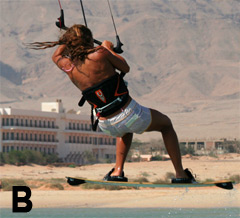 Pic B – The surfer is most definitely rotating into a front loop. You can see how far his front shoulder dipped still down from the take-off and that the surfer has already brought his legs up for balance and speed of rotation. However, the really exciting part of this picture is the bar. His back hand has slid all the away to the end of the bar, so the surfer can get decent purchase to crank the bar in and get the kite turning into its loop. It is also worth noting that the surfer has not pulled his front hand in. It is very easy to pull hard on the back hand and subconsciously pull down on the front hand too. Just keep the bar sheeted in with the front hand and let the back hand/arm do all the work. When learning this move, the harder you pull on the bar and the quicker the kite turns the gentler the kiteloop will be. From here there is no way back.
Pic B – The surfer is most definitely rotating into a front loop. You can see how far his front shoulder dipped still down from the take-off and that the surfer has already brought his legs up for balance and speed of rotation. However, the really exciting part of this picture is the bar. His back hand has slid all the away to the end of the bar, so the surfer can get decent purchase to crank the bar in and get the kite turning into its loop. It is also worth noting that the surfer has not pulled his front hand in. It is very easy to pull hard on the back hand and subconsciously pull down on the front hand too. Just keep the bar sheeted in with the front hand and let the back hand/arm do all the work. When learning this move, the harder you pull on the bar and the quicker the kite turns the gentler the kiteloop will be. From here there is no way back.
KITE CONTROL
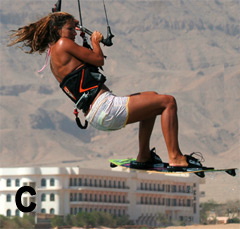 Pic C – To be in control of the kite and make sure it loops, you need to have tension on the lines. Here you can see that the surfer has the bar sheeted in, so the kite will react. Also by making a physical effort to keep the bar sheeted in, you are far less likely letting the bar slide out as the power comes on, which would unfortunately stop the kite from turning. An added bonus is that, as the looping kite pulls, you will feel it through your arms, not just your harness and thus, you will able to keep your balance more easily.
Pic C – To be in control of the kite and make sure it loops, you need to have tension on the lines. Here you can see that the surfer has the bar sheeted in, so the kite will react. Also by making a physical effort to keep the bar sheeted in, you are far less likely letting the bar slide out as the power comes on, which would unfortunately stop the kite from turning. An added bonus is that, as the looping kite pulls, you will feel it through your arms, not just your harness and thus, you will able to keep your balance more easily.
COMMITMENT
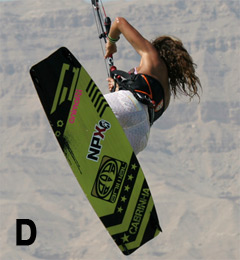 Pic D – The surfer has been pulled around his front loop by the looping kite and the pull of his harness hook. As long as the kite loops, you will always finish your rotation. Even though she is around, if you look closely, the surfer still has the bar pulled right in with both hands thus giving it plenty of hand. It is tempting to ease off because it will feel like the kite has turned further than it really has, but if you do, the best end is the splashing down in like a doggy transition. The surfer is also looking where to go. As a reference, try to look slightly behind of the downwind, this way you can land with speed and then carve out, and if you have looped the kite too fast, you can carve back from where you came, having turned the whole thing into a front loop kiteloop transition.
Pic D – The surfer has been pulled around his front loop by the looping kite and the pull of his harness hook. As long as the kite loops, you will always finish your rotation. Even though she is around, if you look closely, the surfer still has the bar pulled right in with both hands thus giving it plenty of hand. It is tempting to ease off because it will feel like the kite has turned further than it really has, but if you do, the best end is the splashing down in like a doggy transition. The surfer is also looking where to go. As a reference, try to look slightly behind of the downwind, this way you can land with speed and then carve out, and if you have looped the kite too fast, you can carve back from where you came, having turned the whole thing into a front loop kiteloop transition.
LOCOMOTION SEQUENCE
1. Approaching with speed, the surfer has a good check to see the room to get pulled back and downwind by looping the kite without risking anybody else. The surfer got a bit of water under too. The surfer sends the kite back positively, keeping the bar on the sweet spot.
2-3. As the front loop goes, the surfer throws himself forward and down as the kite lifts him up off the water. At this point the surfer levels the bar and sheets in.
4. As the surfer starts to rotate, sliding the back hand down the bar and pulls his knees up and then pulls hard on his back hand to get the kite looping.
5-7. To increase his chance of success, the surfer keeps pulling on his back hand to make sure that the kite turns all the way and also keeps the bar pulled in, so that there is tension on the lines and the kite does what the surfer expects.
8. So far all through the rotation, the surfer has been looking over his back shoulder. As the surfer gets most of the way around the loop and focuses on where to land.
9. With the kite powering around its loop, it spins the surfer around so that his harness hook is pointing at where the pull is coming, slightly behind of downwind. The surfer keeps the bar sheeted in and keeps turning the kite with his back hand.
10. This is the moment of most power as the kite starts to climb back up. The surfer keeps his knees up thus, pulling the bar with his hands to keep the balance.
11. The surfer has survived the loop and just need to stick the landing. With the power of the kite decreasing, the surfer starts to drop. This is his cue to let his feet drop beneath.
12. As his feet drops, the surfer aims for a downwind landing, concentrating on keeping his weight over the board and not to one side or the other.
13. The surfer lands tail first but onto a level board, so the surfer can soak up the speed. Once steady, the surfer carves back onto his edge, with a great relief plus the applause.
KEYSTONES
- Keep bar in to sweet spot on take-off.
- Move back hand down the bar.
- Start kiteloop as soon as you feel you are rotating under the kite.
- Keep both hands on the bar and keep the bar in.
- Look to land downwind over the board.
Here is a video of this trick
Backloop to Blind with Air Pass
To learn this move you need timing and technique because the air pass on this trick is dependent on it, not on brute strength, it is within reach. But, i if you dangle your thrusting hips, it will serve you proud! Also, we will look at this trick as a stepping stone towards the much cooler named KGB.
REPETITION
A good starting place is to go back to the popped back loop, as you’ll need to give yourself time, some extra height and changing of rotation in preparation of throwing in a cheeky air pass.
Once again you will need to practice a slow rotation, so the two reminders to remember are:
1. Where you take-off is where you land (downwind to downwind). So bear off the wind a lot before taking off. This way you will do more of the back loop in the air than on the water, which in turn will give you time to prepare for the pass and reward yourself with and easier stick downwind landing.
2. Mind your head. If you look around over your front shoulder as you take-off, you will spin much faster, so aim to keep your head square with your shoulders and look through the gap between your arms. Not only will this slow down your rotation, it will also make your direction change easy against the flow when you throw the pass.
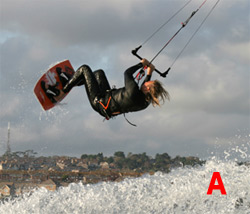 As far as your rotation is concerned, you will need to get more inversion. This does not mean you need to be upside down, but if you look at pic A you can see how the surfer is in a horizontal position and has his knees up above his body. This will stop his body dropping away from the bar when the surfer goes for the pass. The simplest way to get into this position is to lean your body back over the tail of the board as you pop, which will lay you onto your back in the air. As soon as you leave the water, make huge effort on bringing your knees up.
As far as your rotation is concerned, you will need to get more inversion. This does not mean you need to be upside down, but if you look at pic A you can see how the surfer is in a horizontal position and has his knees up above his body. This will stop his body dropping away from the bar when the surfer goes for the pass. The simplest way to get into this position is to lean your body back over the tail of the board as you pop, which will lay you onto your back in the air. As soon as you leave the water, make huge effort on bringing your knees up.
Try to keep your kite around 11 or 1 o’clock, as it will help you with the rotation, body position. It will give you something to physically pull against when you go for the pass much higher and you will be dangling under the kite, and also you will need that extra energy for that.
TIMING FOR THE GO
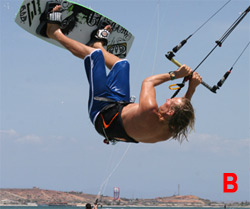 Pic B – we can see that the surfer seems much inverted compared to the previous. However, if you look closely, the only difference is that his feet are higher and his legs are extending, this means that the surfer is going for it. From practicing this trick, you should know the moment when you’re tucked up the bar is close to you and you start to drop down as you complete the back loop. You need to go for the pass just before the dropping time. To give yourself more “float”, kick your legs up just before you throw the blind twist. With the board up, momentarily no force will pull you down. You can see in this picture that the surfer comes further around the back loop and his hips are moving around towards the bar.
Pic B – we can see that the surfer seems much inverted compared to the previous. However, if you look closely, the only difference is that his feet are higher and his legs are extending, this means that the surfer is going for it. From practicing this trick, you should know the moment when you’re tucked up the bar is close to you and you start to drop down as you complete the back loop. You need to go for the pass just before the dropping time. To give yourself more “float”, kick your legs up just before you throw the blind twist. With the board up, momentarily no force will pull you down. You can see in this picture that the surfer comes further around the back loop and his hips are moving around towards the bar.
THROWING THE PASS
Once you have kicked your legs up and the board away, you’re throwing yourself to a blond, just from a rather familiar position. The actions are the same; you will pull hard on the bar with both hands and bring it towards your front hip.
Pic C – You can see that the surfer has pulled, released the bar with his back hand, and is now throwing his head, hips and shoulders around. This is really where the kite position is so important. If the kite is too high, there will be nothing to pull against, and you’ll find it hard to get the blind rotation.
Pic D – You can see how the surfer twists his wrist and thumb down and around, which enables his body to twist around further. Commitment is the key here. It would be very easy to give up and let go but you must reach around with your free hand. If the kite is sufficiently low, your pull before throwing should result in a tiny bit of slack as you drop and therefore making the pass easier.
Pic E –If you have timed it right, the bar will come to you, hopefully before your board touches down. Just let the kite pull our arm around and try to follow with your head for a balanced landing.
Pic F – Voila! When you watch someone doing a trick like this and it looks often effortless, take in mind that you need a complete conviction and your best kite face.
THE COMPLETE SHOW
1. With enough power in the kite and speed under the board to pop against, the surfer has unhooked, pointed off the wind and is now carving hard into his pop. His bum is down and front leg is extended for a decent edge whilst his back leg is slightly bent ready to explode for the take-off.
2. The board turns up and it is time to extend his back leg as the surfer leans back over the tail to initiate a more horizontal back loop. His head is looking forward to where to go for the rotation to slow down.
3. As soon as his board leaves the water, the surfer starts to bring his knees up towards his body. He is still looking straight through his bent arms.
4. Still going up and around, the surfer isn’t looking over his shoulder, but lets the back rotation bring his hips around towards the bar.
5. If you were to look at the bar, it has completed the back loop. However, the surfer will always be following. From practice, he feels the rotation around onto the bar, so it is time to go for it. The surfer kicks his legs up, pulls the bar hard into his front hip, thrusts his front hip up and around and throws the pass. Because the kite is low enough, the surfer has something to pull against to kick-start his blind rotation before letting go with his back hand.
6. Turning the body, the surfer twists the bar around behind his back, enabling him to turn even further and position the bar so that it is ready for his free hand as it reaches around.
7. As if by magic, the bar is where it should be and the surfer grabs it with his free hand, whilst simultaneously releasing his other hand.
8. Dropping down, the surfer lets his arms untwist and lowers his legs in preparation for the landing.
9-10. As the surfer comes in and looks around as to where to go he reaches up for the bar with free hand. Both these movements will help balance the landing. Then regains control of the kite with both hands on the bar and sails on smugly.
Here are some videos of this trick:
Back To Wrapped
This trick is a fairly funky move in in its own right, although you do not get to see them as much. Most riders skip it in preference of going straight into the back move, and once they land, then they are unlikely to go back to the wrapped version. However, if you’re not one of the better riders in the country, this is a very useful stepping stone which will satisfy and build a consistency for more progressive moves.
The beauty of the back to wrapped is that the momentum of a slightly over rotated back loop can carry you around to wrapped. Without stating the obvious, you will need a controlled unhooked back loop to toe side at the very least. If you are already popping to blind, then this will help. Even though blind is very different, having a natural bar pass will make life easier.
POP LATE
In many pass tricks, the difficulty is in slowing your rotation down. In this one you need to speed it up. The simplest way to do this is to carve your way up into wind before popping off your back leg. This late take-off will spin you faster and will send you into a second rotation, at least to toe side, without you having a moment’s thought. The only disadvantage is that you won’t have much time to prepare for the rest.
ELBOWS IN
When you carve into the wind it is more likely that your arms will be pulled out by the power in the kite. As soon as you leave the water, you need to get your elbows tucked into your side. If you can get them in, your hips will roll onto your hands, which keeps the bar in close and enables you to keep your balance and pass.
TWIST AGAIN
You need to rock your back knee in order for you to stay with the move. As you rotate with elbows pulled in, you will need to lift both knees. This will not only speedup your rotation but will also place your back knee high enough so you can kick it through. This knee force will accelerate your second rotation and will take you past the landing toe side. Remember to twist your wrist once you release the bar with your front hand as you will be able to turn your shoulders further. Once you get the hang of things, you can even pull your hands in and steer the kite down as you push through. This will bring everything together at your hips and helps keep the kite lower for landing, preventing it from pulling you out of position and off balance.
TOUCH DOWN
It is all good when you are through with all that leads, but it means nothing if you are not ready for the touchdown. To stick this you will need to get around to downwind preferably a bit further. To increase your chances you should try and land tail first, as the back of the board will then pivot you around a touch further. To make this possible, get your weight on the ball of your feet, not your heels, otherwise you will keep slamming. Finally, keep looking around so your body will turn to face your intended direction of travel and make the pass behind you considerably easier.
GIVE IT A GO
pic 1 – The surfer has checked for space, turned off the wind and unhooked, hands on the center of the bar with his weight over his back foot.
pic 2 – The surfer carves hard into the wind, dropping his weight low and resisting the power by driving against both heels, making sure to take the weight of the kite on both hands evenly to stop any unwanted kite movement.
pic 3 – The surfer has carved further into the wind than a normal pop would do. His head is turned to look right upwind over his shoulder. Also, as the board turns up into the wind and under the surfer, there is a little resistance from the edge so pulling his elbows back in has been started already.
pic 4 – When the surfer feels that there is less pressure on the bar and on her legs, the surfer quickly pops. This means that the explosion off her back leg will accelerate his spin. You can see that the surfer extends his back leg as it pushes him around as opposed to up into a huge pop. The timing here is very important, If you leave it too long you won’t even get enough height to complete a back loop.
pic 5 – Because the turning off so far on the water, the surfer is already three quarters around his back loop as soon as the rotation is in process. His aim is to keep his elbows in and bring his knees up making him smaller because this will help keep momentum going for the rotation to wrapped, and by lifting his knees, the weight of the board will not pull him down away from the bar too soon.
pic 6 – Coming around the back loop, the surfer’s trailing knee is up near the bar and his hands. As he continues to rotate, his hips will follow his knees and roll towards his hands. Once you have tried it enough to give your brain some time, this would be a good moment to jerk our hands in and even steer the kite down as you do so. At this point, the surfer must keep looking over his shoulder and around into the next rotation. If he were to focus on where to land, it will slow his spin and prevent him from getting around.
pic 7 – A split second before this shot, the surfer have really pushed his back leg and knee just as his hips rolled towards his hands. So he have done it with both hands on the bar to keep the kite from going up and allowing him to get hands and hips as close as possible. As the knee comes through, the surfer lets go with her front hand and keeps looking over his shoulder.
pic 8 – As the surfer turns, the wrist is twisted and the thumb pointed towards the small of his back. This enables him to turn further. He lands back foot first with weight on the ball of his feet. The board will pivot further around here without the surfer catching his heel side edge.
KEYSTONES
- Carve hard and long, lead with head.
- Elbows in.
- Knees up.
- Both hands to hips before releasing.
- Twist your wrist.
Here are some videos of this trick:
Aaron Hadlow shows how to make a back 2 wrapped
Konstantin Tuludis also knows how to make this trick
As well as Ariel Corniel
Shifty 2 Wrapped
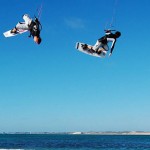
This is a cracking move, which look phenomenal, feels amazing and is actually easy to nail consistently once you have got it. So what is Wrapped? If you haven’t contemplated what landing wrapped is, try visualizing that you are about to land toeside but you continue rotating and turn the board for you to be able to rotate another 180 degree to land heelside whilst releasing your front hand. The effect is that you’ll land with your back hand twisted up in half behind you.
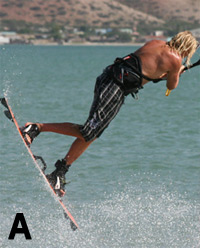 Pic A – We can see how the surfer used his back foot and the back board. The front foot is lower than his back foot and his back foot is further upwind than his front foot. In fact, the shifty has been lifted at the end of the board whilst his extended front leg has pretty much left the nose of the board.
Pic A – We can see how the surfer used his back foot and the back board. The front foot is lower than his back foot and his back foot is further upwind than his front foot. In fact, the shifty has been lifted at the end of the board whilst his extended front leg has pretty much left the nose of the board.
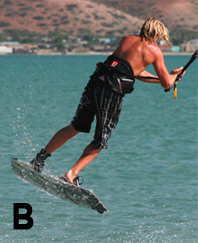 Pic B – As soon as the
Pic B – As soon as the 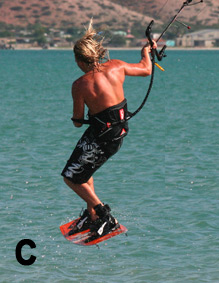 surfer stops holding his shifty position, the gravity takes over. His back foot and the weight of the back board drop down and accelerate as they go, creating some high and useful momentum. Once again the static front, which isn’t falling, acts as a pivot point so the back leg starts to swing around for toeside landing.
surfer stops holding his shifty position, the gravity takes over. His back foot and the weight of the back board drop down and accelerate as they go, creating some high and useful momentum. Once again the static front, which isn’t falling, acts as a pivot point so the back leg starts to swing around for toeside landing.
Pic C– This picture shows the result of a tasty amount of rotation which should be an easy task for you to get around the wrapped.
The only thing left to do then is to release your front hand, twist your wrist around and turn your head. Do not let go as you aim to land in a wrapped position.
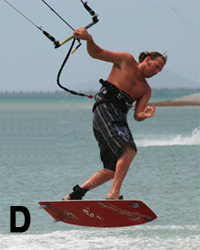 Pic D – Shows that the kite drifted up and the surfer does this move with his hand centered on the bar with the chicken loop line in between his first two fingers.
Pic D – Shows that the kite drifted up and the surfer does this move with his hand centered on the bar with the chicken loop line in between his first two fingers.
SHOWTIME SEQUENCE
1. As per usual, the surfer has come off the wind to unhook and set himself up for take-off. The surfer pushes the board out in front by extending his front leg which gets his weight over the back foot. The more off the wind the surfer goes the less carve to far up into the wind and get a raley take-off.
2. The surfer gets back onto his edge by dropping his weight to upwind and carves the board against the pull of the kite.
3. With his weight over his back foot, the surfer allows him to be pulled up and explodes off his back foot. Immediately leans his head over his back arm and keeps his front leg extended. Because the kite isn’t too high, his arms do not get pulled up over his head.
4, As the board leaves the water, the surfer keeps his front leg locked and starts to swing his back leg upwind.
5. With the board pivoting around his front leg, the surfer keeps his weight forward, holding the nose of the board down and lifts his back foot up towards his backside.
6-7. Once the surfer feels that landing is near, on the way down the surfer release his shifty and let the board swing down. At the same time pulling the bar towards his back knew as savagely hard as possible and kicks his back knee towards the bar. This gets the rotation to wrapped underway.
THE LANDING AND THE PASS
1. Having pulled the bar toward his knee and kicked his knee towards the bar, the surfer is spinning fairly and rapidly. The surfer twists his wrist as the turn is on for the preparation of the bar, which also allows him to turn his shoulders further. His head is turning to look where he is going and his right knee is still driving around.
2. Having turned, the surfer’s main aim is to land on a flattish board and hold on to the bar. To do this, the surfer rotated around and got his hips centered between his feet. This will give him a stable platform to land on and give him the balance to pass the bar. You can also see that his palm has turned all the way up. This means that the bar is ready and waiting for the other hand, and it also stops the shoulder from getting pulled.
3. With the bar twisted and waiting in place, the surfer reaches up with his other hand and grabs the bar from underneath with his free hand and palm up. The surfer also starts to stand tall.
4. Now that the surfer is upright, the surfer quickly releases the bar and cunningly gets out of the wrapped arm lock.
5-6. The surfer turns his head and looks where to go, reaches forward to get two hands back on the bar and hook back in.
KEYSTONES
1. Front leg straight
2. Back leg up and round
3. Big effort from hands to knee and knee to hands
4. Twist your wrist and shoulders
5. Land with weight slightly on toes
A video of this trick:
Unhooked Downloop
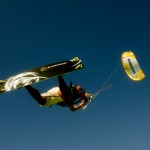
The unhooked downloop is a satisfying piece that unluckily does not get enough airtime these days. When it is at home this move is performed with a pop at the same time the kite loops in a forward direction, which unavoidably will pull you forward into a raley position. As the pull from the kite comes from your front, it is not that too aggressive, and it is another unhooked move that can be easily performed when you surf at an agitated water. Finally, this trick is the originator for a downloop S-Bend.
ALL IN THE TIMING
In pure timing terms you need to be popping early. You should be able to pop from the speed that you take into the move. This way you do not need to let the kite loop move to give power to perform the pop. The result of this is that you will be going up as the kite starts to go around, simply meant that you will get more land and height as the kite finishes its loop move. The longer you wait the lower the kite you’ll fly. This will also end up with the kite starting another rotation before you land.
UNHOOKING A HIGH KITE
Your first concern is the position of your kite. Ideally you will have your kite pretty much at 12 o’clock to start this move. It is good, but you need to unhook too. This means that your approach needs to work for you. With your kite high, the problems of slowing down and not being able to unhook are lurking in the wings. On your approach you will need to drift the kite up at the same time edging hard and then at the last minute bear away loads to slacken the lines off and then go to unhook. Your body position here for unhooking is crucial, so make sure that you push your hips up and shoulders back, otherwise the chicken loop will not slip out easily.
REDIRECTION
Next you need to get your hands sorted. You need to release your back hand and reach forward to grab the bar just underneath your front hand in a fish pole grip during the redirection phase. There is no relevance to whether you are right or left handed. The important thing only is that your front hand steadily stays up against the center line and the released back hand grabs in close to it as possible. If you have just lathered up with some factor 50, this could prove a tad tricky. The slick movement to one side of the bar will get the kite turning sharpish into a downloop.
THE POP
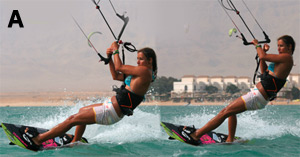 You should be well aware by now of the need for a decent edge to pop-off. If you enter with the correct body position, it will be easy enough to get onto your edge quickly. Your shoulders should be in a back position and your hips forward. Even more importantly is that you need to extend your front leg, so your hips are over your back foot and aim upwind while your hips and shoulders twist. This will allow you to drop your bum low to the water and get into a solid craving position in a quick time. Notice how the surfer has already started to drop into carving after the back hand is released. By doing this, the surfer will have a perfect phase to pop off from the edge before the kite gets too far into its downloop. The surfer will explode up off his back leg by suddenly straightening it, kicking it down onto the heel of his back foot to pop perfectly.
You should be well aware by now of the need for a decent edge to pop-off. If you enter with the correct body position, it will be easy enough to get onto your edge quickly. Your shoulders should be in a back position and your hips forward. Even more importantly is that you need to extend your front leg, so your hips are over your back foot and aim upwind while your hips and shoulders twist. This will allow you to drop your bum low to the water and get into a solid craving position in a quick time. Notice how the surfer has already started to drop into carving after the back hand is released. By doing this, the surfer will have a perfect phase to pop off from the edge before the kite gets too far into its downloop. The surfer will explode up off his back leg by suddenly straightening it, kicking it down onto the heel of his back foot to pop perfectly.
ENTERTAINING AIR
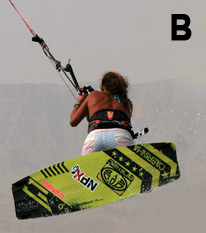 Once you pop up into the air your objective is to follow the pull of the kite. By doing this you will keep your balance and will give you an enough inclination for the landing. The simplest way to go with the kite’s pulling force is to watch it. You can see that the surfer is being pulled through the air by his downlooping kite. Head is in line with the bar, which is pointing at the kite. In a powered downloop, your feet might flick up slightly behind you. As long as you look at the kite, it will not twist you. Also by looking up at the kite, the surfer’s head is lifted. This will make it easier for his feet and board to drop underneath. If you feel the need to take off a hand off for balance, then it must be your back hand.
Once you pop up into the air your objective is to follow the pull of the kite. By doing this you will keep your balance and will give you an enough inclination for the landing. The simplest way to go with the kite’s pulling force is to watch it. You can see that the surfer is being pulled through the air by his downlooping kite. Head is in line with the bar, which is pointing at the kite. In a powered downloop, your feet might flick up slightly behind you. As long as you look at the kite, it will not twist you. Also by looking up at the kite, the surfer’s head is lifted. This will make it easier for his feet and board to drop underneath. If you feel the need to take off a hand off for balance, then it must be your back hand.
TOUCH DOWN
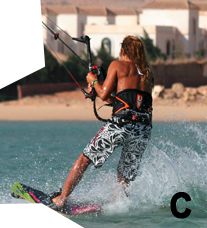 As we mentioned keeping your head up, allow your body to fall into a normal vertical position. If you can keep your arms, or front arm bent, the pull will bring your leading hip forward and set you up for a pleasant downwind landing. The surfer is upright over his board. This gives him the option of going either way depending on where the kite is going.
As we mentioned keeping your head up, allow your body to fall into a normal vertical position. If you can keep your arms, or front arm bent, the pull will bring your leading hip forward and set you up for a pleasant downwind landing. The surfer is upright over his board. This gives him the option of going either way depending on where the kite is going.
When you first land a downloop, follow the kite downwind and watch it loop again. As you see it turn through the center of its rotation and is starting to come up, grab the back of the bar with the hand you swapped over. If you do not get the right timing, just grab the chicken loop and let go of the bar. At least the kite will flutter up and you can sort yourself out.
SEQUENCE FOR THE POP PREPARATION
Pic 1 – The surfer approaches with the kite around 11 o’clock and starts to drift the kite up with a sudden pull-away to allow the body to be pulled up over the board, flattening it and pushing the front foot towards the kite and leaning with the back foot with weight over.
Pic 2 – The surfer forces his hips forward and up at the same time pulling down with both hands.
Pic 3 – As the surfer pushes the bar away and the chicken loop out, the surfer starts to drop his bum and shoulders away from the kite and looks where to go and not at the kite.
Pic 4 – The surfer swaps hands and starts to get back on the edge by driving his feet away.
Pic 5 & 6 – The surfer twists his hips and shoulders to face more upwind, forcing the board to carve hard onto its edge. The kite is starting to steer down and will pull soon
Pic 7 – The surfer pops up hard off his edge extending his back leg.
SEQUENCE AFTER THE POP
Pic 1 – As the surfer pops up the kite, pulling forward is the main goal with offering no resistance at all.
Pic 2 & 3 – The surfer looks towards the kite to keep the balance all the way.
Pic 4 – As the kite starts to rise again, it stops pulling and the surfer starts to drop down. Keeping the bar pulled in with bent elbows, this turns the surfer naturally to follow the kite.
Pic 5 – With the head of the surfer up, the feet and the board drops under and releases the back hand for some added balance.
Pic 6 – The surfer lands over the board, waits for the kite to rise, and then gets the other hand back on the bar.
KEY MARKS
- Kite at 12 o’clock
- Unhook with shoulders back and hips forward
- Change hands
- Carve and pop early
- Follow kite once in air
The video of this trick:
Kite Loop to Wrapped
The Kite Loop to Wrapped is a desirable technique in its own right which demonstrates superior control and landing satisfaction. Though it is also a vital step to kite loop 3, surely, there are benefits in learning the wrapped version first.
Firstly, you have more time to focus on the kite loop as the timing for the spin is a last minute thing. Rather than looking forward for the moment to spin, better to wait for it. Secondly, you don’t need much height so you can get away with less power which makes a more pleasant learning experience. Thirdly, as an outcome of both of the above, to succeed is all about technique and has nothing to do with aggressive force. Once you’ve got it, you can move onto the full 3 version a whole lot easier.
If you are coming into this as a relatively new recruit to wrapped, it is recommended to practice on your shifty to wrapped first as this is the primary building block of a quick spin to wrapped.
HIGHLIGHTS OF THE TRICK
THE TAKE OFF
Whether you’ll be going for a kite loop with or without wrapped or a pass, what your kite does will affect your chances of success, and what your kite does is remarkably influenced by your approach and take off as you’ll be learning this technique with a fish pole grip, you have no way of controlling the speed at which your kite loops with your hands instead the rest of your body.
Chances are, when you first attempted an unhooked kite loop, you changed your hands and the kite looped before you had time to think, dragging you off downwind vigorously and most likely splash you into the water. The simple reason for this is that you need to pop to get off the water and let the kite do the rest when you’re up. If you just edge hard, you put more tension on the lines and the kite moves fast.
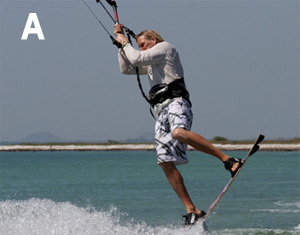 In Pic A, the surfer basically just eased off downwind with the kite at 12:00, unhooked and reached under and back with front hand to grab the back of the bar and popped up off the back leg right away. You can see how the surfer’s whole body from feet to shoulders is aimed upwards and not back against the pull of the kite. Because the kite is not breaking the surfer up off the water, maintaining the arms bent is easy and therefore keep the bar close.
In Pic A, the surfer basically just eased off downwind with the kite at 12:00, unhooked and reached under and back with front hand to grab the back of the bar and popped up off the back leg right away. You can see how the surfer’s whole body from feet to shoulders is aimed upwards and not back against the pull of the kite. Because the kite is not breaking the surfer up off the water, maintaining the arms bent is easy and therefore keep the bar close.
Because the surfer is no longer resisting against the kite, it will turn slower. And because the surfer has popped up, the kite will hurl up providing more height effortlessly. The longer you carve on the water, the more vigorous the break from the kite, the further back the kite loop and the lower he resultant jump.
This will only be possible if you unhook with your front leg pushed out in front of you, your hips dropped right back over the rear foot and your shoulders back. From this state, you can swiftly carve and pop.
THE SHIFTY
We use the term shifty freely as we don’t want to get into any discussions about style. Let’s agree that in this case what we mean is the extension of the rear leg behind us. As with the shifty to wrapped by kicking your rear leg behind while in the air, you then can bring the knee up and through which will assist you to spin faster and further. For sure there are many surfers, who spin without extending their leg first, but we’re in the market of making this easier for all involved, and this absolutely helps.
The other benefit to this position is that it allows you to use the “flick” of the kite. This being the point at which the kite tries to knock you off balance, usually by swinging your legs forward as the kite turns back. With the back leg extended, you can then pull the knee up towards you to regain your stability and hyphen up your rotation speed.
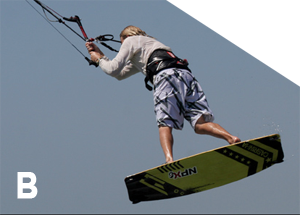 In Pic B, you can see that the surfer kicked his rear leg and foot up behind as the kite pulls. As with the shifty to wrapped, the surfer didn’t let those arms extend, instead keeps the bar close. Looking at the image, you can see that there is almost a straight line running from his hands through his back knee to his rear foot. If you were watching the kite, it would just be turning through the bottom of its arc and is beginning to rise.
In Pic B, you can see that the surfer kicked his rear leg and foot up behind as the kite pulls. As with the shifty to wrapped, the surfer didn’t let those arms extend, instead keeps the bar close. Looking at the image, you can see that there is almost a straight line running from his hands through his back knee to his rear foot. If you were watching the kite, it would just be turning through the bottom of its arc and is beginning to rise.
THE ROTATION
More lower body work out here. It is all about getting your hips, legs and board to turn. Your upper body will follow your head but if you don’t get the lower half moving, it’s good as nothing.
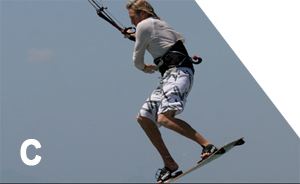 In Pic C, the surfer is dropping and feels that there is much less pull in the bar. This is the signal to start spinning and this is the advantage of learning to wrapped. In this image, there are two important things.
In Pic C, the surfer is dropping and feels that there is much less pull in the bar. This is the signal to start spinning and this is the advantage of learning to wrapped. In this image, there are two important things.
Firstly, if you look at the surfer’s right foot, you can see how it is lifted off the footpad. This indicates just how vigorously the surfer has pulled his knee, foot and the rear of the board forward towards his hands. Because of the shifty, the surfer was able to do this.
Secondly, look at the position of the left hand. It is almost wrapped around. This is because the surfer has not pulled the bar into his back hip, but rather has pulled the bar past the hip and down as if pulling a paddle along the side of the raft. So the hands have been drawn down towards where the rear foot was and the knee had been brought forward to get the board under the bar and the bar under the shoulders.
Once you get the board under, you can then rotate with your head to get your upper body around on a vertical axis. If you rotated before the knee came through, the board would be left behind, and you would rotate off axis and be dragged off balance.
FINAL STEPS TO REMEMBER
Before you go for any wrapped landings, give yourself more allowance by knocking out a handful of unhooked kite loops first. Aim about taking off early, extending the rear leg and feeling the tension disappears as you drop. This way, you’ll get a sense for when you need to spin and also provides you the right amount of power and height. If you feel like you are overdoing it, it may not be the right day to try.
Consider trimming your kite too. You want your kite to be looping circular, not to be turning around its wing tips. On the majority of kites, if you don’t trim them down enough to unhook, they will flare/reverse/halt. This will result in a tight wing tip axis and won’t give you the feeling that you need or much of a chance of succeeding. Defined and controlled is better than wild and unpredictable as you can build on it.
SEQUENCE SUMMARY
1. Have a good look around to make sure you have enough space. The surfer moves his kite up to 12 o’clock, pushing the board off the wind with a straight front leg unhooks with his shoulders still back.
2 & 3. After unhooking, you need to reach under and back with front hand to fish pole the bar, drops weight back and upwind.
4. Hard carve upwind and ready to pop…
5. ..and explodes up off the rear leg before the kite starts to pull. When you pop, you need to keep your arms bent and the bar in close.
6. As the kite loops back and down, it’ll pull you towards it. Kick the rear leg out behind and hold on tight. To help with balance, you can look over the bar towards the kite.
7. As the kite starts to rise, it stops pulling and you’ll start to drop as well. This is the perfect time to spin just as you feel the power. Pull arms in and down past the back hips hard and pull the rear leg in even harder.
8. Keep pulling on the bar, try to pull it past the hip and release only the front hand as your lower body and knee will come through.
9. With the lower body turning, start to turn your head and shoulders so that you can continue to spin far enough to land with the board pointing downwind.
USUAL PROBLEMS
- If you find that the kite drags you hard downwind and not skyward. For sure you are edging too long before popping up. Don’t wait for the kite to pull, just change your hands and pop.
- If you still couldn’t get enough height. Make sure that you start with the kite positioned as near to 12 o’clock as you could. You should hurl the kite up before you unhook.
- If you bounce off the back of the board when you land. You are not getting your feet forward enough as you rotate. Always bring your knees all the way through and up.
- If you can’t reach for the bar. Make sure you pull the bar down towards you and keep your arms bent all through the loop. Finally, you’ll need to pass out the wrapped nice and quick; otherwise the kite will just continue to loop around.
KEY MARKS
- Kite at 12 0’ clock
- Pop up early
- Keep arms bent
- Kick rear leg back
- Bring hands and back knee together when you feel the power coming.
You should do like this:
S-Bend Pass
The S-bend pass
Your next phase on from landing blind is the S-Bend pass, or the aggressively popped front logo pass. It’s a blind judge tagged onto the end of an S-Bend in the same way that blind is tagged onto an S-Bend. The secret lies here, once more you will be combining two different moves that you could hopefully land, which in contrast to discovering something that is totally new from scratch. Remembering all this, give yourself enough chance to think about the goal you are trying to attain to get this job done.
Let’s presume that you could successfully perform a smooth S-Bend, the chance is that you will finish in your fast rotation and consequently land thereafter with sufficient time to throw in a very swift last minute blind. You are going to need a bit more of elevation to pave way for a more successful pop and dare. Such option is suggestive of a smooth rotation finish and more time for a pass that is similar to a blind judge. You’ll be pulling big time and sway your front leg in the process so as to spin and acquire stability while closing the bar, thus, not trying to rotate into the pass from your spin but rather pull into the pass as you would normally.
Six Crucial Moments in the S-Bend Pass
1. With a light bar, sufficient height and good timing, you can achieve all the good pop you wish. In the demo picture A, we can see that the surfer is all set to pop and do a trick while preliminarily positioning the kite at 1 o’clock with some bursting speed. The idea is to come up with a good pop, so keeping the shoulders behind the hips while slightly flexing the knee gently and putting all the body weight over the back of the board would be the proper position for a pre-pop. Doing this, you could still have full control of the board as well as the kite for a maximum pop. Even though the aim is to rotate forward, the surfer is edging just as he would strongly proceed into a Raley. For a bit of height, this is the perfect timing to hurl the kite up in assisting a launch through the stratosphere.
2. In this picture, the surfer succeeded to do a good pop by pushing against his rear leg really hard, kicking at the rear end of the board. With an absolute speed, well positioned kite and proper body mechanics, this will lead you in an average ping forward and up. There is no chance for the surfer to move forward towards the kite – he doesn’t have a choice. Keep in mind that the extended rear leg is still straight from the launch and most importantly, the point when the board and the surfer’s front leg have flicked upwind while the upper body is turning the other way around from the rotation. Though randomly, this is by chance a laid out full Monty S-Bend. Allow the legs to be left behind by turning it upwind, only then you could break out from the rotation into a position which you recognize and rely upon from the Blind Judge. Give enough time and focus for just a split second after launching before releasing your upper body into the rotation. In addition, by keeping the elbows in on a rather chest level would facilitate your head to swivel around more quicker and with a lot of ease.
3. This is the outcome of the launch previously described in the other picture. The surfer could already start to mark his landing at the middle of his rotation, or at least see the water surface. This will give him such an instinct that will allow him to get set and be ready for the pass. From this particular position, the goal is to get your head and hands approximately around the rest of the rotation. Make sure that you have given enough height allowance before you go for the pass.
4. You should always remember this particular position, as it is not too far-off the position and you’d be in pre-Blind Judge post Raley. The legs and the board are high, upwind, flicked back and the bar is turned palms upwind, it’s just the shoulders position that is a bit off, but they’re on their way around. With the front leg extended and up, the surfer now pulls hard, taking his hands down towards past his right leg while pulling his right knee up towards the hand. This would get the rotation for an air pass under way. Concentrate and keep yourself focused because the next critical part to worry about is to submit to the pass.
5. As the kite surfer’s front leg swings down and under the bar, he releases his back hand and turns his head, just as he would be in a Blind Judge as he twists his front hand down and around. This lets his head and shoulders turn further into an airborne blind. Although in this demo picture the legs are frozen slightly behind him, they are actually moving forward at a high velocity as it swings downwind towards the bar.
6. The result of which is that the legs rock the board under the bar. This puts the surfer in a rather less intimidating position with his weight under the board and his feet under him. It will then allow him to perform a rotation around his front arm while aiming for the pass with his free back arm. Just like the Blind Judge, you can do all possible good work leading up to this point. but if you do not look for the pass with your free hand, good things are not most likely to happen. The moment you have passed the bar, try to hold your arm closer to pull your shoulders up for a neat landing just like a pro.

Helpful Tips
Before trying the air pass come out from a variation of soaring S-Bends, do not hesitate to find out which best works for you. Landing them successfully should be easy even at the end of your rotation up high, for this shows that you are going to do the rotation effectively and not over-rotate into the pass.
Once you have stabilized and assembled both your confidence and your alertness of your position in the air, go for the pass. Keep in mind that you may need to grasp onto the bar a tad longer than you think before holding the bar with your free hand. If you set off immediately, you won’t be able to spin timely for a pass.
Review sequence 1 and 2 to attain a plan of the timing. We’re not going to tackle everything but try and observe the part where the pass is “activated” up high. You will have limited time if you just wait further going down, time is of the essence, so better get that S-Bend done early and so timely.
Encountering Common Problems
The classic – the bar pulling up and away as kite goes high. If you stick into this move conservatively, you will not obtain the pop, so in order to make up for it, you’re going to hurl the kite right up and achieve the pass as high as possible. Go and locate some deep water and give the launch a nice preparation.
Another common problem is passing the bar and the board when still too distant from you and even upwind when you get the pass (but never from landing because it is really on your side edge). You are not pulling your legs underneath and swaying them under the bar. So remember to toughen both your legs and arms as well. When your knees come up untimely or early, you cannot sway your legs through, so give them a nice extension behind during takeoff time.
Kiteloop 900
Ok, I´m not going into details on this one, it would require a few pages of text probably… I assume that you already know how to make a Kite Loop.
What you have to do in order to perform the kiteloop 900 trick is to add a few thing…
1. Add a 360 rotation with a handle pass.
2. Add another 360 handle pass rotation.
3. Make a 180 rotation and land toeside.
Do these 3 moves while the kite is looping and you´ll end up doing a kiteloop 900!
From where do you get the 900? 360 + 360 + 180 = 900
The kiteloop can of course be made in variations. It´s probably a smart thing to start by doing a kiteloop 360, then a kiteloop 720 and so on… Havn’t yet seen anyone making a kiteloop 1080, but perhaps will Youri Zoon make one year 2012 or later. Here is he at least doing a kiteloop 900, watch and learn!
Back Mobe
Back Mobe is an unhooked back loop followed by a handle pass in the same direction as you travel. So in essence you´re doing a 720, two full rotations from the carve. The major problem people have when they try to perform this trick that they´re not sure if they are doing one spin, two and a half spins, one and a half spins or two spins, it can all become a bit confusing in the air.
Knowing this the fundamental behind a back mobe is a decent pop with a slow rotated back loop. The image below shows what we are aiming for.
I t doesn’t matter if you land toeside or heelside. Your aim is to end up with your hands and hips together and your body fairly horizontal as you complete a full rotation. The key elements here are to keep your arms bent and bring your knees up. However there are many building blocks which don’t all follow the same path, so lets have a quick look at two of the most popular roots.
The back to wrapped. A great move in its own right and a potentially good lead into the back mobe. Only thing going against it, is if you are deliberately keeping the kite low to help you around the rotation, you will be throwing yourself around, trying to over rotate in order to land wrapped, which will do nothing for your pop or kite control. On the positive side it teaches you to hold onto the bar once you´ve released your back hand – this is a good thing!
The back to toeside. Yet again this can be a great step up to the back mobe but only if you see the toeside landing as a comfy alternative to a heelside landing. It´s very tempting to keep the kite low, say around 45 degrees and really throw yourself around. Once again you won’t be working on pop or controlling your rotation.
We want to try and get some elevation with our back loop from our back leg and we want some time in the air. To make this all a bit more achievable you´ll need to have your kite just under 11 or 1 o’clock, about 75 degrees if you´re into angles. The danger is now that you´ll spin under the kite so you need to work on how you rotate, the axis, and this is what takes the practice. By looking at the individual parts of the back mobe we’ll hopefully uncover how to get there in a controlled fashion.
So lets guide you through the steps.
The single most important part of the set up to a controlled unhooked popped back loop. To bear away off the wind and unhook you must bend your back leg and really move your hips towards the tail of the board, pushing the nose off the wind. This way his weight is already where it needs to be to get a tight but quick carve upwind. Try not to carve off the wind on your toes as this will move your weight forward, making it much harder to resist against the kite and pop. But do make sure you go off the wind enough before carving up as otherwise you´ll take off too late, spin too quickly, and won’t have time to think.
Carve hard upwind to initiate the back roll. Note that the front leg is fully extended, toes up to keep the front foot from pulling out of the strap, whilst your back leg is flxed and ready to pop. Even though your shoulders are leaning back into the rotation which will help you get horizontal, your hips are twisting upwind to allow you to resist against the pull of the kite, which keeps the board in between you and the kite and will let you pop off the back leg.
Firstly getting some up from the pop. Having initiated a good carve as in picture 2, kick down of your back leg before you get pulled over the board and it turns through the eye of the wind. Secondly keep your arms bent. This will allow you to rotate your hips towards your hands. If you had straight hands you wouldn’t be able to get your hands and hips together by the end of the back loop as the distance between them would be to great. Finally keep your head firmly between your shoulders and look forward. By not looking over your front shoulder you should rotate at a controllable pace, using the momentum from the carve to turn you. This means that you can save the energy from your head and use it slightly later on when you´ll need it.
At this picture you are just about to finish your back loop. You can see that because your arms are bent the bar is not to far away. Imagine where the bar would be with extended arms… yup, no chance! This is where the practice pays off, as you need to anticipate this moment just before it happens. The more slow rotation back loops you do with bent arms, without trying to pass, the more time you will have to think as it seemingly happens slower and slower, and therefor the greater chance you have of pre-empting this moment.
Just as you approache this moment, you throw your head and shoulders down and around, which has the effect of rolling your hips up towards your hands. By keeping both hands on the bar you will have the strength to roll your hips up to the bar towards your hands as your head and shoulders go down, which in turn starts to twist the bar around behind your ass. Its really important that you don’t pull the bar into your hip with your back hand as the kite will rise and pull the bar away from you when you go for the pass.
You will know when to let go because you´re arm will be in the way! The main difference between learning the back mobe and watching the pros do it, is that they will be letting go so much earlier than you´ll get away with at the beginning. If you´re a bendy kid your limbs may let you pass some distance for your body, but if you´re a grown adult, keeping the bar in close for that little bit longer makes life considerably easier. You can see here a similarity between the secret of many pass moves, the bar is already twisted enough to grab as you let go. This allows you turn more, and more quickly and means that you don’t have as far to reach with your free hand. You can help yourself here by keeping your knees bent which will stop the board from dropping and dragging you away from the kite.
Nothing too complicated here as the bar is waiting for you so you don’t let go. Keep both hands on the bar for a split second. By holding on you can rotate around your arm and therefor keep the bar nearer for your reaching hand. If you let go a fraction too early the bar will ping away and you´ll miss it. However the speed ay which you reach around to grab the bar is the key. You want to take the shortest and quickest route around your waist with as little movement as possible. If you’re already claiming Shifty 3s you should be used to this, but if you´re new to passes practising passing a bar behind your back on dry land will serve you well.
As you can see in the picture, the front arm is bent. Its all good and well passing the bar with wnough height to land, but it won’t mean jack shit unless you sail away. A nearly will give you confidence but a landing lets claim it as in the bag. By keeping your arm in after passing, the kite will pull you around enough to land comfortably at speed on a flat board. If you let your arm pull out straight the chances are you just won’t turn enough and you´ll get pulled over the nose of the board when you land. This can be the most frustrating part to conquer. After you pass try and bend your arm from your elbow so that your hand comes towards you shoulder rather than pull your hand in towards you.
Top Tips
Once you´ve obsessed about back loops with a slow rotation and are ready to go for the pass, really try to visualize the movement of one slow back loop followed by a second very quick off axis rotation. As Walt Disney said, “if you can dream it you can do it”.
If you have a tendency to list the kite as you go to pass try pushing down on the bar as you turn your head down. With the bar twisting down towards the water this pressure will stop the kite from moving.
Summary
- With the kite around 11 o’clock and weight well back over, carve hard into wind with your hips and shoulders, explode up from your back leg into a slow back loop.
- Keep your arms bent and hands close as you leave the water. Look forward.
- Bring up your knees as you start to rotate.
- Three quarters the way around your back loop it’s time to start use your head.
- As the back loop is completed, throw your head down and around towards the water to initiate the pass, but hold onto the bar with two hands, twist it around you so that you can roll your hips up to the bar.
- As your hips rise and meet your arms, release the bar with your front hand.
- Swing your free arm around and in front of your waist and continue to twist the bar around behind your back.
- Reach back around your harness.
- Rotate around your back arm until you can grab the bar with your front hand.
- Once the bar is grabbed release your back hand.
- When you drop lift your head to keep your weight over the board.
- Lift your left hand towards your shoulder to stop your arm from extending and pulling you off balance.
- Land over a flat board, reach around to grab the bar and sail off.
Common Problems
Your kite drifts up fast as you try and bring your hips up.
This is most likely caused by you trying to pull the bar down to your hips rather than bring your hips up to the bar. Try hold the bar with both hands and use the movement of your head and shoulders dropping to pivot your hips up.
That said splitting the fingers of your back hand over the centre line will help to keep the kite from moving up as you go to pass. And if you feel you must pull the bar in make a conscious effort to steer the kite down with the front hand as you pull.
You land on your board still moving, but you didn’t manage to grab the bar. This is a classic for riders getting into the mobe.
The reason for this is likely to be that you are trying to throw a double rotation, rather than control a back loop and then pass. As a result you are spinning on a more vertical axis, your hips won’t roll up and you have no chance to get near the bar. If this is happening to you, go back to the slow back loop and try to separate the two rotations.
You always pass, land and then fall.
This was a personal favourite and has everything to do with not holding the bar in once you´ve passed it. If your arm just extends like rubber you´ll get pulled off balance as the board brakes on impact. By keeping the hand nearer to you with tension on your front arm you and the board will move forward on touch down.
Keystones
- Carve hard with weight back to initiate back loop.
- Look forward for a slow rotation.
- Head and shoulders at end of first rotation.
- Hold on with both hands until hips up.
- Hold on with back hand until you grab the bar.
We end this article with a nice little video from Progression Me
